RB Racing Intercooled Turbos...Big Twins and VRod
Turbos...RB Racing Horsepower Perspective
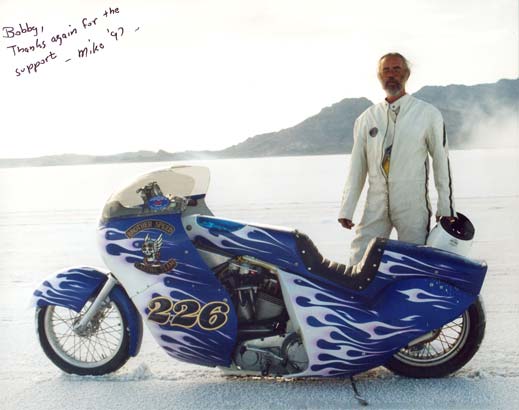
In the Early 1990's we were
making 275 hp out 104" Evo motors like Mike Geokan's famous #226 Blue
Bike. We did not run them higher because we limited the airflow with
the turbos we chose.
The bike featured our RSR Fuel Injection System with four 50lb/hr injectors running in a stage mode. We wrote a fuel injection program for it and that program was never changed. We wrote the program before the bike turned a wheel with the turbo. There was no testing. Mike was adamant about "not wanting to learn anything new". He didn't have to.
Early on at Bonneville the #226 bike would suddenly shut off running about 22 psi of boost...something we had never seen before with Suzukis, Harleys, Kawasakis or any other turbo bike. We had brought spare microprocessors. The RSR ECU had two microprocessors, one to house the operational code and one to house the serial programming data. When the bike shut off we checked everything and switched the microprocessor that held the data and the bike ran again but in subsequent runs shut off again. We figured it was electrical interference from the spark plugs as it happened under high load. Mike's solution was he would need a pile of microprocessors and change them after each run. We asked him which glove he put on first before he ran...left or right. All he had to do was alter that order and the bike would run. That went over well. We drove back to LA made some additional changes on the input programming circuits and drove right back up to Boise...that's 1800 miles driving with no sleep and insisted the bike be re-wired to get the plug / ignition wires away from our electronics.
To this day more that two
decades later the bike still runs and Mike still believes you have to
change the "chips" after each run. No...It was the gloves.
These days we no longer
have to run four injectors in a staged arrangement as injectors 2200
ccm or larger are available in high impedance (12 Ohm) values.
Prior to that, in the late 1970's and early
1980's, we were making 150hp Shovelheads. In the early 1990's we
manufactured our own closed loop RSR EFI system for our turbos...that
powered Drag Racing Harleys to a 7.75 @176mph and a National Pro Gas
Championship in the quarter mile.
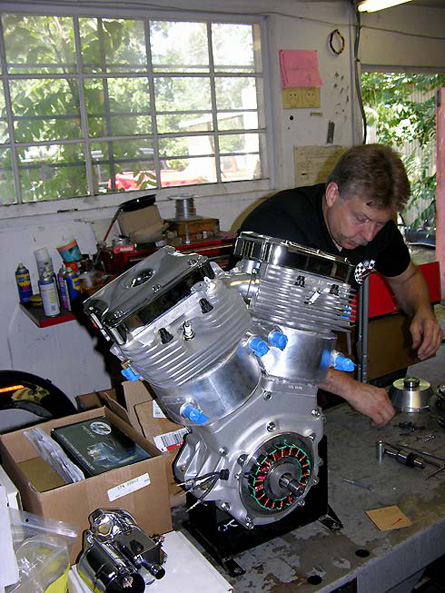
Above picture: Carl
Pelletier of Competition Motorcycles delivering the 139" Turbo ORCA Motor to
be installed in the Bonneville Bullett. RB Racing designed all the special parts
like the 1/2" A-1 cylinder studs and the water-cooled cylinders as well as
the pistons and other items. John O'Keefe did the porting and installed
the Ferrea valves we had made. Carl did all the final machining and
assembly. We used the engine to test new ideas...Some worked and some
didn't but we never lacked power..Over 400hp.
Our Bonneville efforts
these days use sophisticated Cosworth Pectel SQ6M
controllers and 500
hp turbos. Our street bikes come with 360 hp turbos. Horsepower depends
on a lot of factors like displacement, rpm, boost level , and cylinder head design...
And, as it rises, the Harleys show their weak
points...clutches, cylinder sealing, cranks and connecting rods, and
final drive belts to name a few. Carl Pelletier above with the RB Racing Bonneville
139" ORCA Single Cam motor with 8" rods, no gaskets, turbo ported SA B2
heads, Inconel valves, custom 1/2" cylinder studs, 32-2 crank trigger crankshaft ,
and water cooled barrels. Not one Harley part. Way past 400 hp.
Horsepower can be gotten by anyone if you cram the can full and light a match. The question is.."Is the engineering good enough for it to be reliable and is it practical enough to be driven anywhere"...Fast is a given. People forget the rest...like practical air cleaners for high horsepower. Always look at the air cleaner...if there is one...And, would you put that air cleaner on a V8. It's an IQ test.
No Direction Home...Bob Dylan
People spend $15,000.00 on a T143 (Engine, 70mm efi throttle, exhaust, install) to get 165hp. We got 275hp 30 years ago with a 104"motor and lately 200 hp at low boost with a 95" motor...and 345 hp with a Bonneville 139" motor with 19 psi of boost. Logic in the horsepower chase is missing.
Turbos are just low compression motors
(8.5:1 or so)...not 10.5:1 heat sinks. 40 years ago we were doing 150hp
Shovelheads. Nothing has changed.
Hey...it keeps people busy
chasing the pecking order dream. First place is always turbos, although
with lots of nitrous, a bit iffy piston-longevity wise, can
provide explosive power increases.
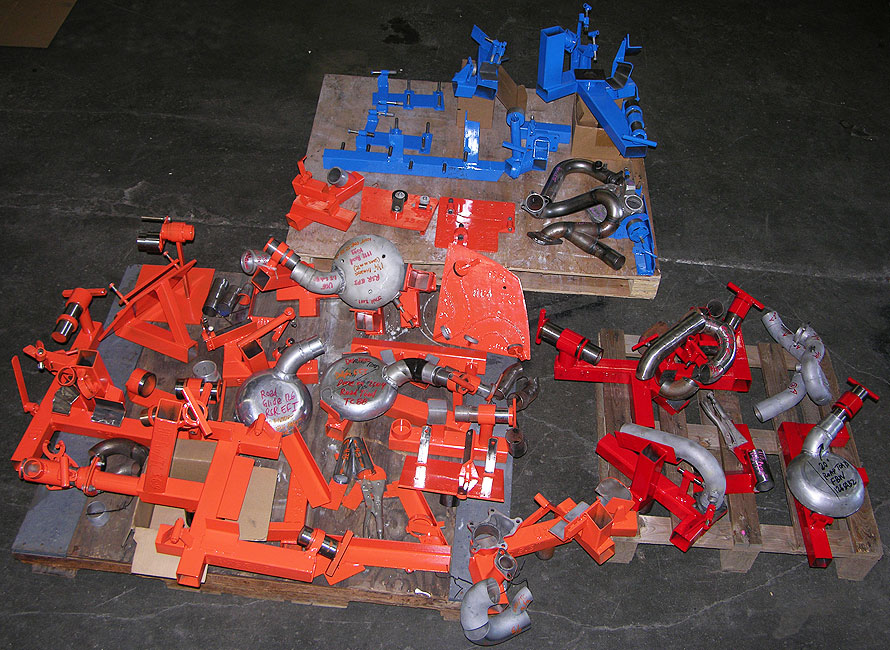

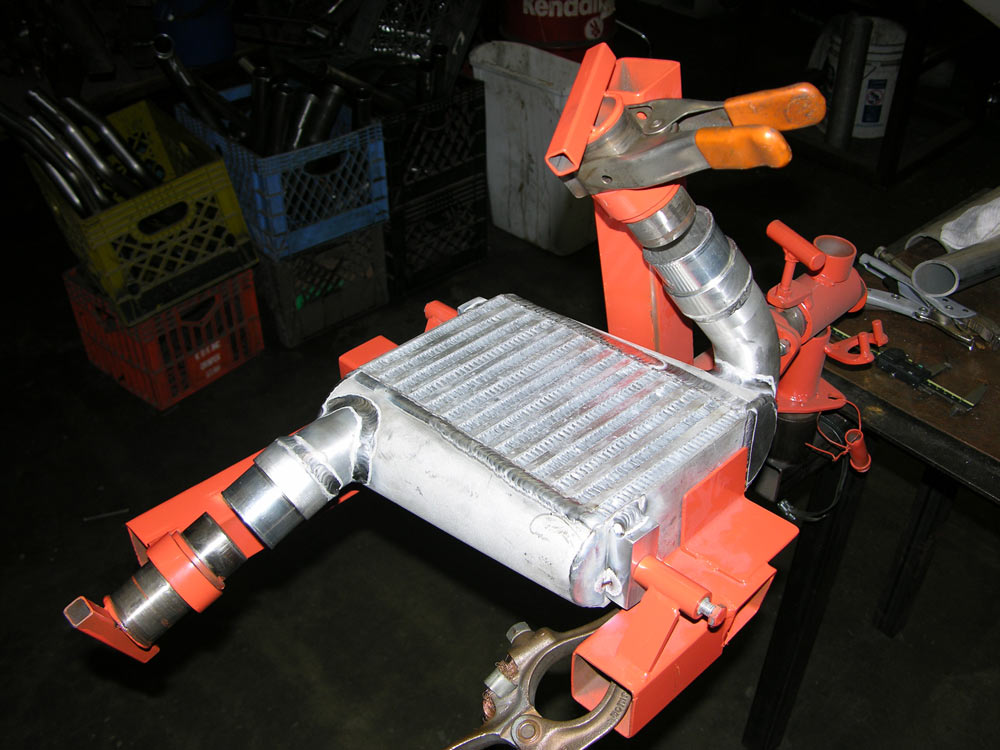
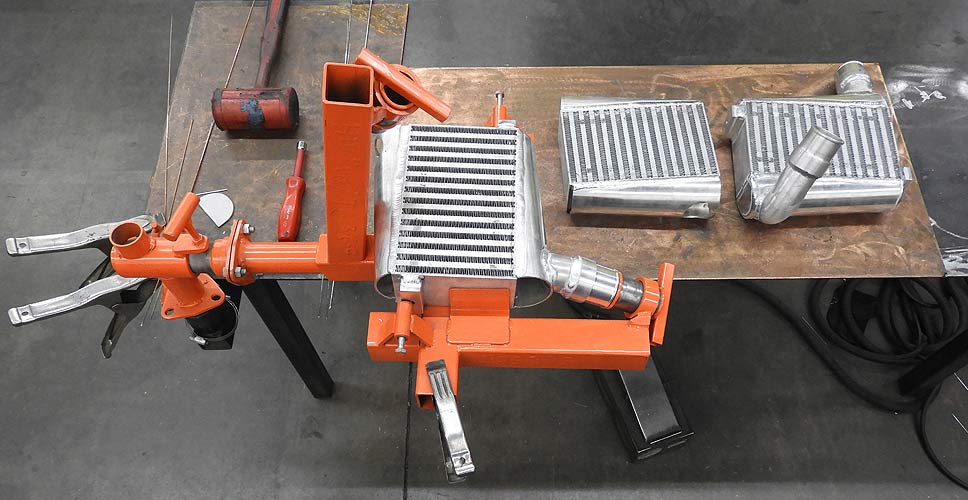

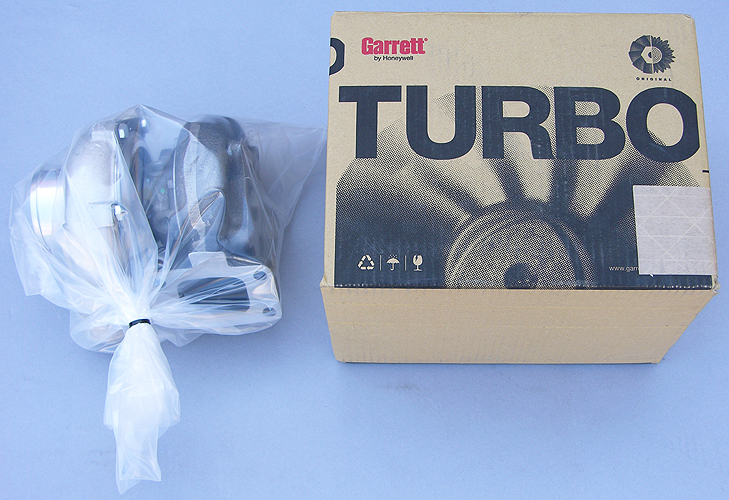
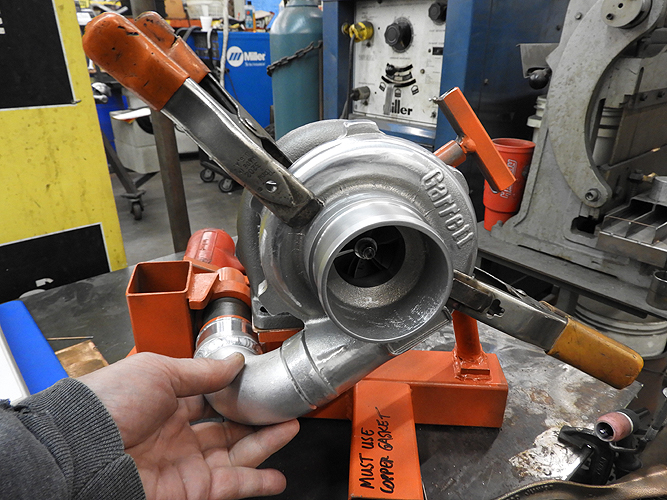

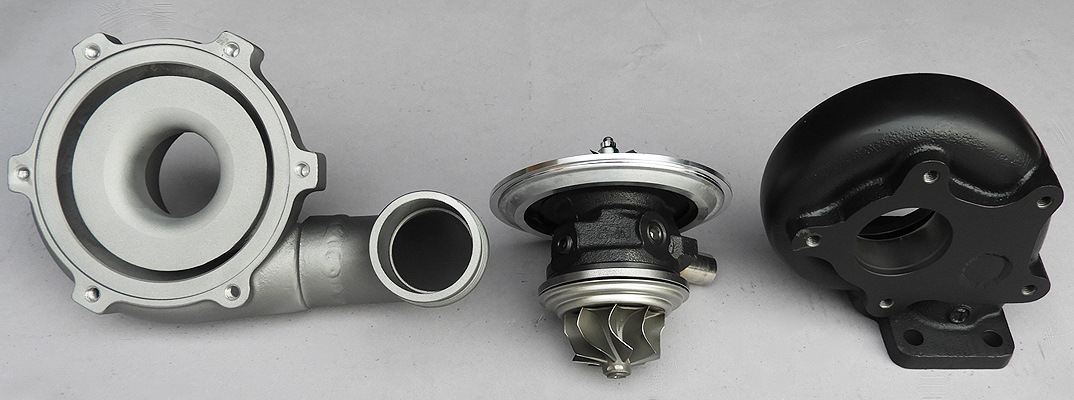
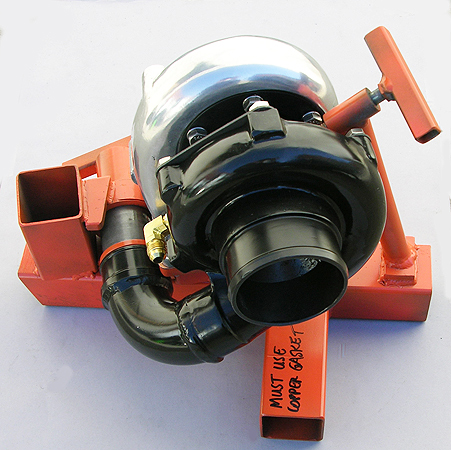
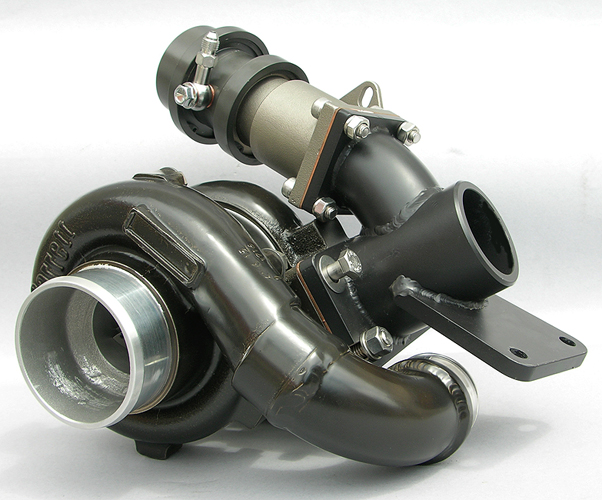
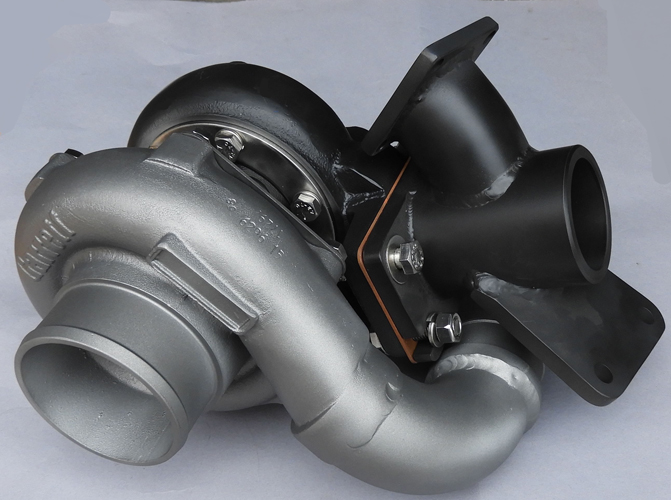
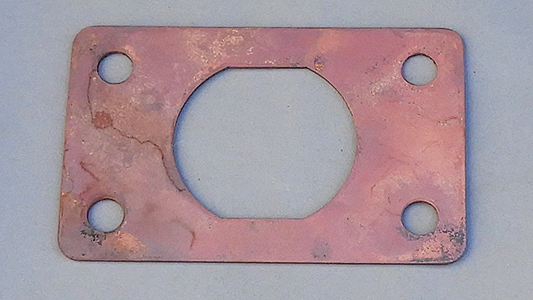
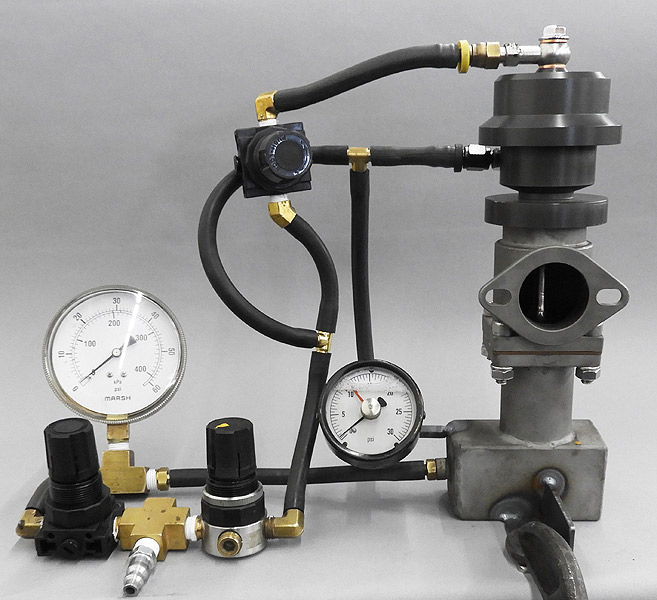
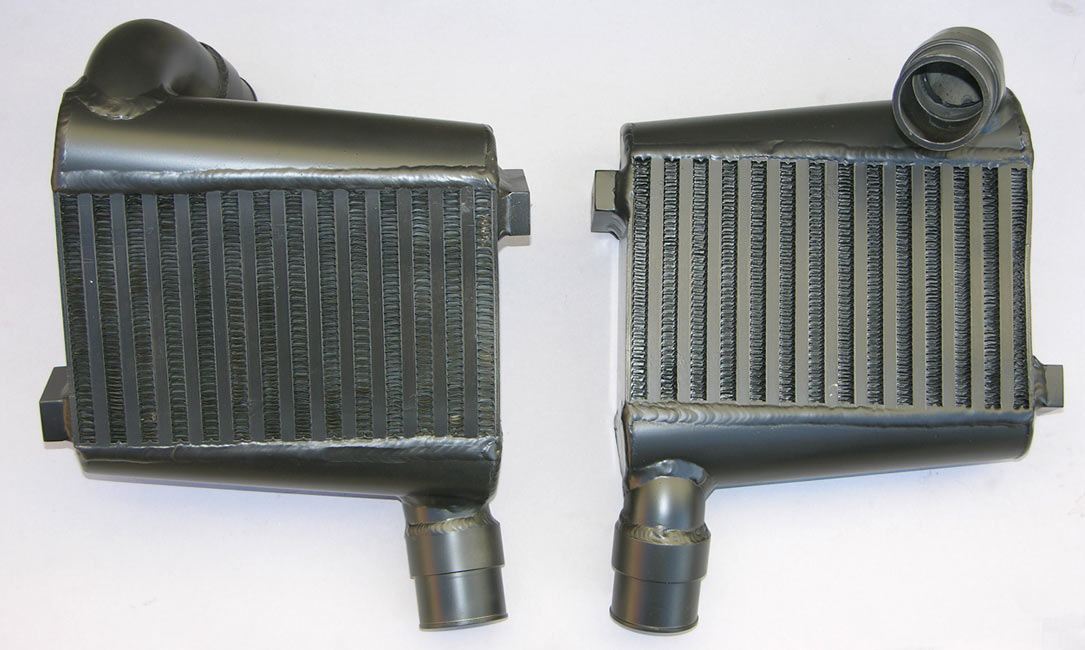
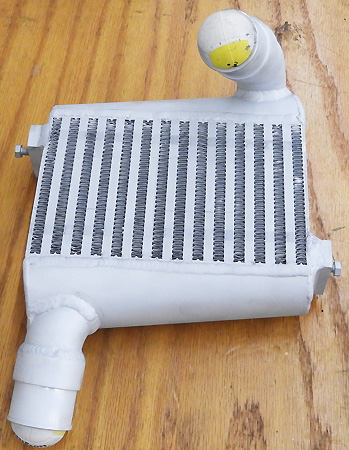
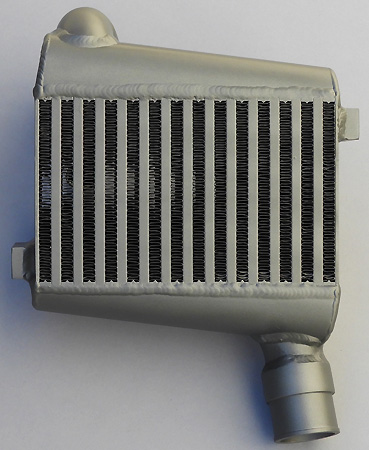

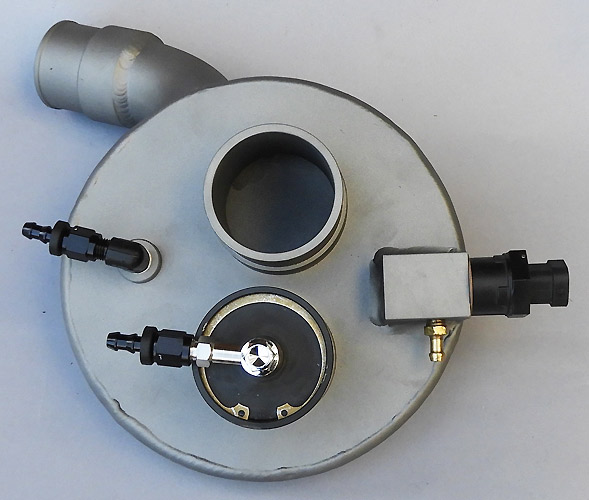
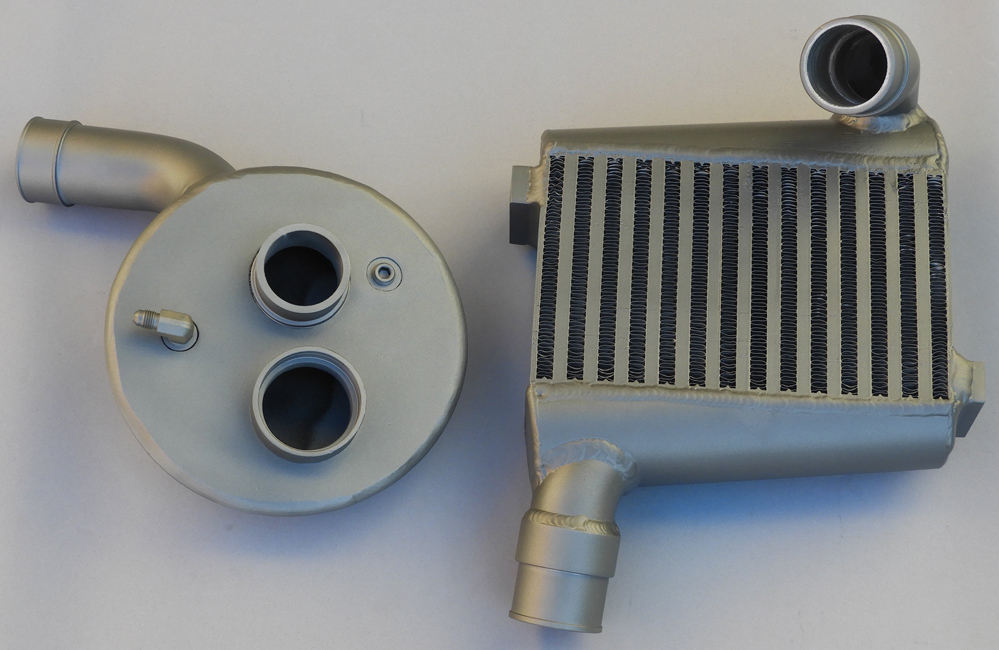

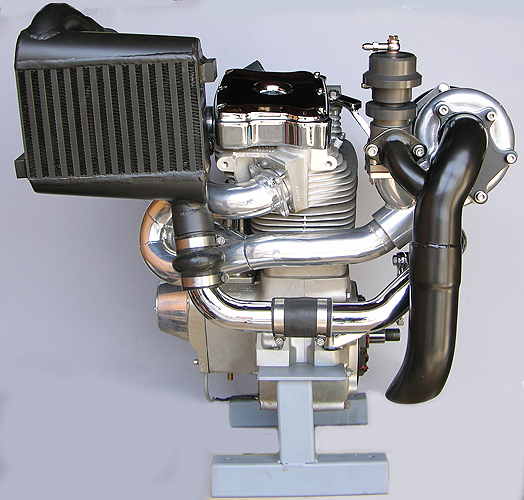

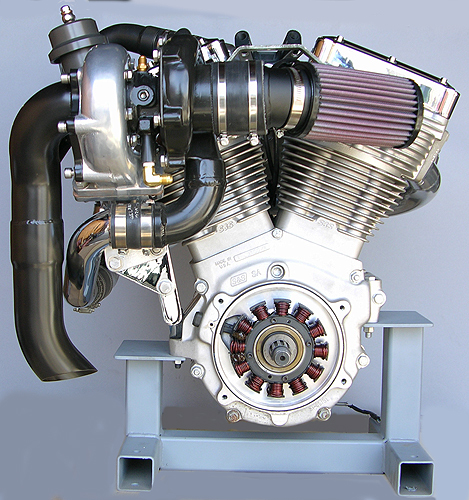
165HP @ 9 PSI Boost... 2003 Twin Cam 95 Cubic Inches

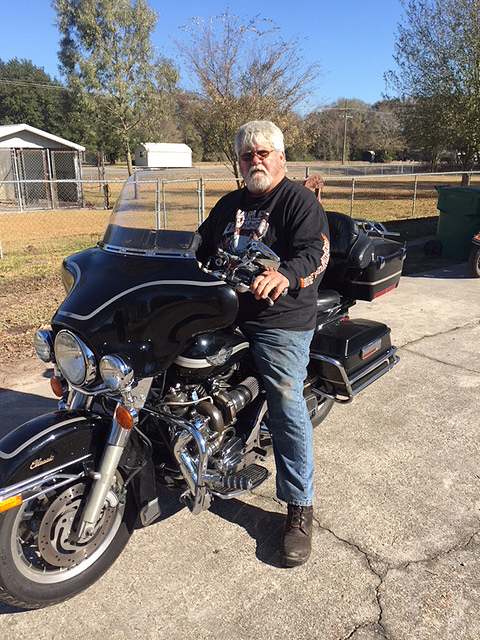
Torque is the game..Take it
to 4 or five psi of boost, short shift, and do it again...80 mph
instantly. Or, if the handlebar adjustable boost control knob is set at
9 PSI, get 165 hp now. Torque allows you to effortlessly roll-on and
pass that line of Semis, or leave the other bikes behind. Tuning perfected in actual riding with RSR Dual Air Fuel Ratio Gauge.
On the above bike, with 95 cubic inches, it makes 200 horsepower and
over 190 ft/lbs of torque on pump gas @13 PSI of boost. Boost is
adjustable to 25 psi.
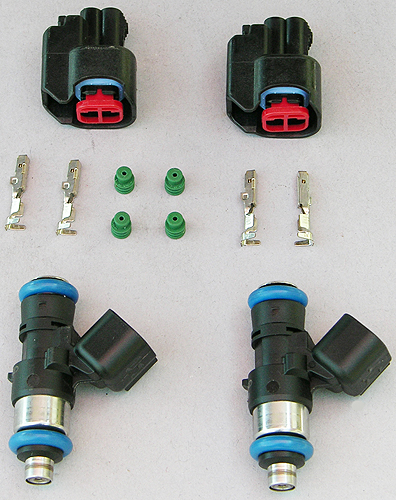
Perry on his 95" Twin Cam
with his OEM Delphi controller reprogrammed with RB Racing's 236hp
Injectors (9 gram/sec). TTS MasterTune.
Doc Sweeney: "Trip done: 5950 miles 28 States in 9 days. Bike performed well"
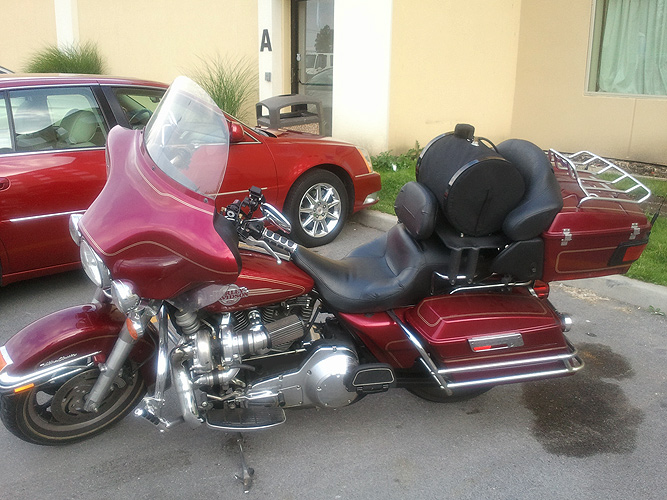
Doc Sweeney and his TC88 Turbo on a marathon 28 state run. Genuine Pinto gas tank along for the ride. "And miles to go before I sleep". Doc Sweeney covered 4500 miles in the first week.."running fine". Next up...a R1200GS BMW and off to Alaska...all 50 states. The TC88 was shipped in from Hawaii. All 50 States.
Oil spot behind the bike is from a Honda Goldwing that had an unfortunate movement when it saw the turbo.
Something Wicked This Way Cometh..Road Toad

There
is nothing that outruns turbos. You have to build big inch high
compression motors to make power and they are not your best daily
drivers or anything you want to take on a trip.
Only turbos give you a stock or low compression engine with power you
can dial up at will. If you want fast and civility you pretty much have
to go turbo.
We use large 360 hp turbos that deliver enough air to outrun anything. Even at 8 psi you will outrun any built 110 and at 12 psi it will leave a SE 120R engine like it was standing still. You can drive it coast to coast and not have to worry about passing a line of semis in the middle of nowhere...Whoosh! We like Road Glides but, at 850 lbs, they are short-changed in the power to weight race. We can correct this.
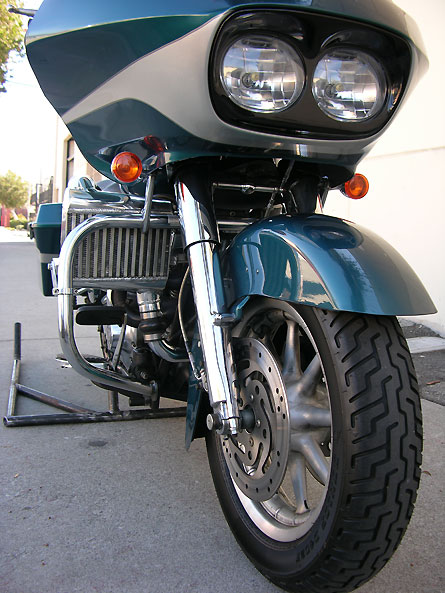
We've been at this turbo stuff for a long,
long, time and made all sorts of variations on Big Twins over the past
30 odd years dating back to Shovelheads.
These FLT/FLH turbos are the
best we have ever done and are light years better than anything else
out there, technically as well as practically.
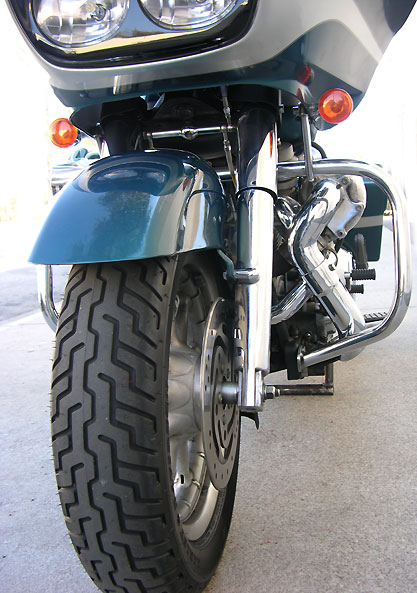
There is no compromise in ground clearance and no hot turbo tail pipes next to your leg either on the left or right side of the bike. The intercooler drops charge temperatures close to ambient and is sized correctly for the power output. A turbo without an intercooler, or too small an intercooler, is just plain stupid. These pictures were taken after 9000+ miles of testing.
Leg clearance is the same
as with a normal air cleaner and everything right and left resides
within the stock crash bars. You can ride like a cruiser or play road
racer without any compromise. We like high speed turns and squirting
ahead of crotch-rockets is an interesting pastime.
Road Glide Turbo aka "Road Toad"

Our
2004 FLTRI Road Glide aka.."Road Toad". Good way to cover a lot of
ground in comfort.
Road Glides, like all Harleys, have a low center of gravity and
peculiar reverse triple clamps that give quick steering but keep the
trail at 6". Add a turbo and it effortlessly whisks past other bikes,
semis, hills and anything else it comes up against.
Testing:
Whenever we let people ride it they come back amazed at how civil and
quiet it is and the way it just keeps pulling in any gear. The last guy
that stopped to ride the Road Toad was a Canadian customer of ours who
turbocharged his GL1800...complete with front and rear laser jammers
and other evading mechanisms we can't mention...He was really
impressed..except for the brakes. We upgraded those later on. We have had customers from as far
away as Australia stop by to ride the Road Toad.
We typicaly do about 10,000 miles of
testing before we go into production. When we are too busy to ride we
have "Turbo Ron" keep putting miles on the bike as he has had two of
our turbo kits and has over 1,000,000 miles of motorcycle riding and
has been on Glides for a long time.
126 ORCA...Building a 360 HP Road Glide aka Road Toad
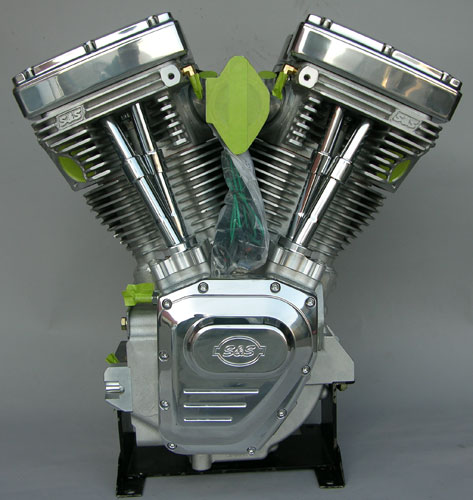
Road
Toad Upgrades:
We upgraded the suspension parts, brakes, and put in the 126" Orca S&S SA B2 engine
that we got for the Road Toad. When the 126 Orca
engine went in the belt drive went South and a chain final drive was
installed. To handle the increased power we installed a full race
clutch
assembly and converted it to hydraulic actuation. The 126" S&S SA
B2 engine fits FL models through 2006. Ours is a 2004 so it fits.
How much does this all
this cost?....About $15,000.00 for the specialzed
turbo motor and another $15,000 for more sophisticated high-end engine
electronics, complete mil spec wiring, and an
advanced sensor package. All in due time.
You can follow the progress by clicking
on the above link...Later models (2007
and later) can
get SE120R engines but these also
have to be built for turbo use...forged turbo pistons, stronger piston
pins, better bearings, and revised oiling systems.
Brief Turbo History: We've been at this for over 30 years and have designed more turbos systems than about anyone...Last time we counted it was for over 25 different motorcycles a dating back to SOHC Honda 750's, not to mention Shovelheads, lots of BMW's, Kawasakis, Suzukis, and even odd ones like old Triumph Bonnevilles...Probably about 1500 Turbo systems in all. These days we limit ourselves to Harley's and certain BMWs. We stopped making turbos for the in-line Japanese fours after setting a large number of speed records at El Mirage and Bonneville, winning magazine contests and horsepower shoot-outs. We put off the redesign of these Big Twin turbos for five years while we were working on the Bonneville Bullett bike...there just wasn't time or money to do both. Development is way more expensive than it used to be and we choose our projects more carefully these days.
We don't do this for the money, that's for sure...It's way too much effort going in for what comes out. It's more of an art form and we do it because we like turbos, and we like being with our friends on projects like the Bonneville Bullett at Bonneville...and we like to ride.
Forged SE120R Turbo Pistons

We had some clients with
SE120R motors in Baggers with 12:1 Compression pistons and Hurricane
Heads...still not enough power. A 360hp RB Racing Turbo and some forged
lower compression turbo pistons was the answer. They also had to go
chain drive with one of our billet chain drive
conversions. We keep these in stock. Note the Top Fuel type piston pin.
The pistons come in at 393 grams with thick domes for the added
compression. $500.00 per set. These are setup for the stock multi-layer SE120R head gasket and 4.060" bore.
Radial Mounted 4 Piston Calipers
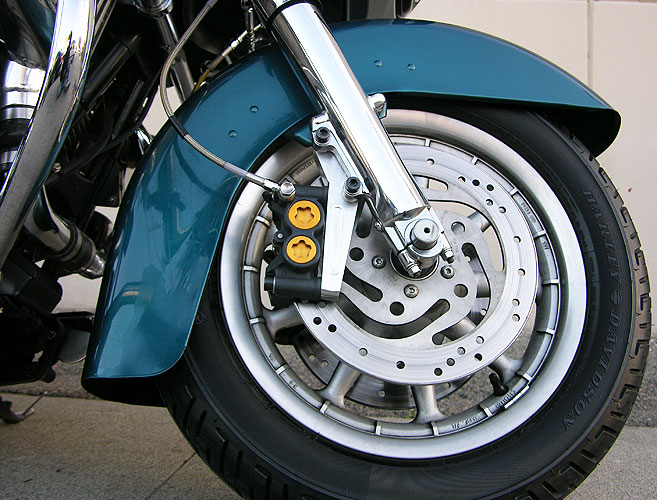
Turbo Exhaust
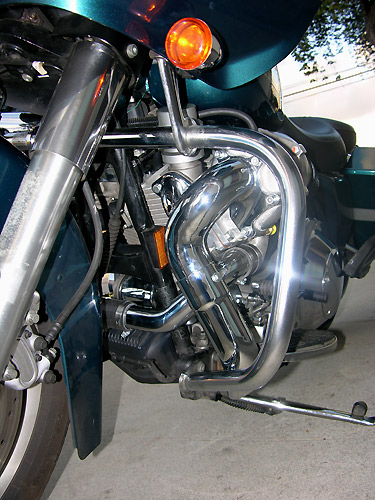
Turbos are surprisingly quiet and they don't like any restriction on the exhaust side...We use a precision heliarced and chromed 2.5" two piece dump tube that does nothing to restrict your velocity. It exits below your floorboards where the heat is not a bother. It does not run inside your leg...we did that one time 30 years ago and decided it was not a good idea. You don't see any seams on our welded parts. We are way too professional for that. No long tail pipes...we went down that road a long, long, time ago...31 years ago to be exact.
Turbo Art
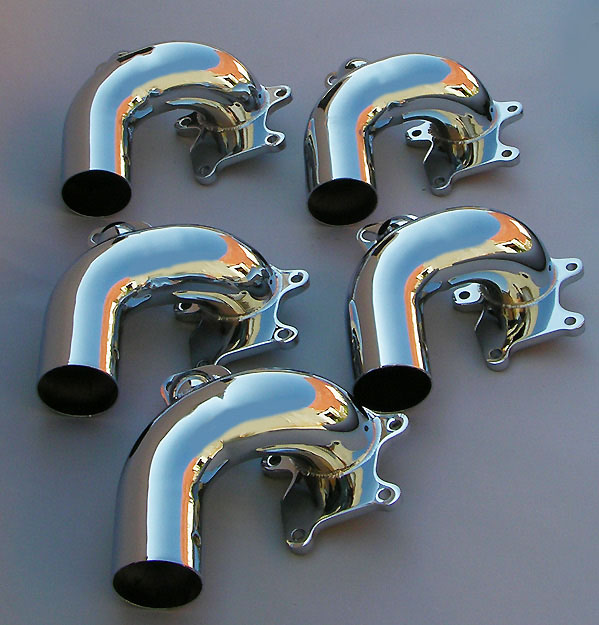
Turbo exit pipes headed for
various client bikes...Road Kings, Road Glides and Ultra Classics.
Secondary pipe bolts or is welded to these for exit beneath the floorboards. Quiet,
no restriction. No long pipes or mufflers to rob power or break. After
over 30 years we know how to make things that work, make maximum power,
and don't break.
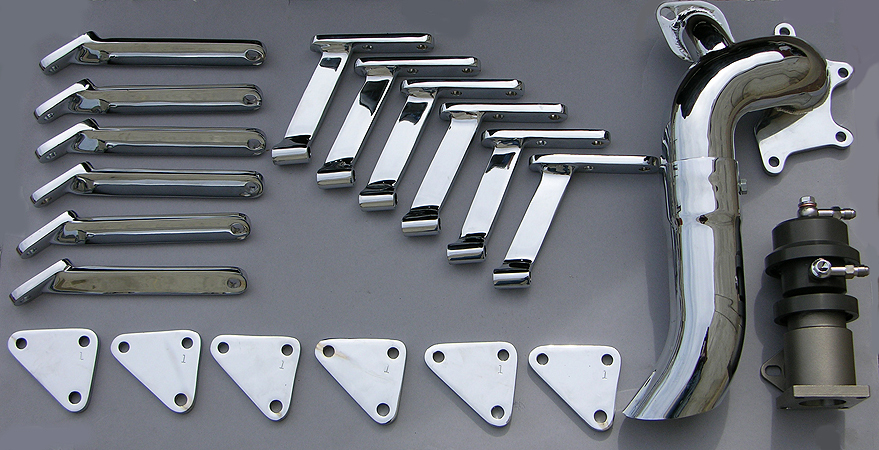
Over 30 years of turbo art and develeopment. A goes to B to C to D to E and so on...and then you go really fast.
Turbo Movie 01...Road Toad 8 psi
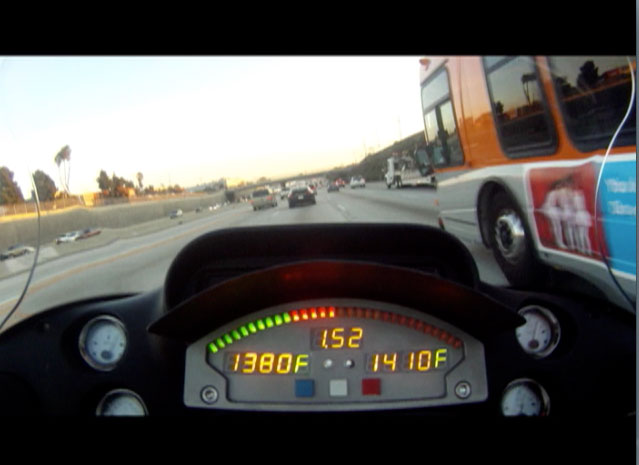
Our Twin Cam 88" Road Toad in rush hour traffic in Los Angeles. There isn't much open space in L.A. like there is going up the middle of Nevada on the way to Bonneville. This gives you a brief idea of what low boost looks like on a Road Glide Twin Cam 88" with Branch O'Keefe Turbo porting and some mild SE 251 cams. 1.52 Bar is about 8 lbs of boost.
No, we did not wind it out
to 140 mph, nor turn the boost up to 25 psi...not in LA traffic. Not
with cameras on the freeways and pesky good-natured citizens with
camera cell phones calling the police. 30 years ago we had ambulance
drivers calling the cops when we zipped by them under boost...That took
awhile to figure out.
Turbo Movie 02... Full Dashboard
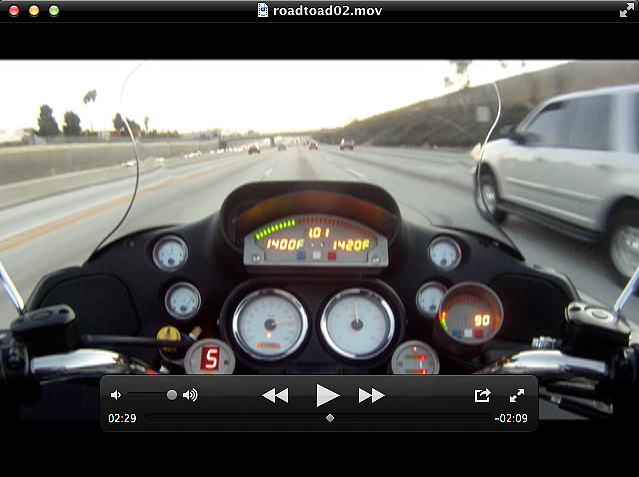
A movie on a gentle
cruise
and acceleration at only 1.5 Bar (8 psi) we moved the camera back so
you could see all the instruments. Our additional injector controller
handles fuel requirements under boost. You can see it activate in the
lower right hand Dual Air Fuel Ratio gauge. The topmost red l.e.d will
light when the 3rd injector kicks in. For street use we like to keep
EGT numbers around 1450 Deg F. The Orca Turbo Dash will also display
Celsius. In this movie the Optional Priority Breather Valve has been
installed.
We have also posted
this video to YouTube.
Newly Redesigned Big Twin Turbo Systems
|
|
|
|
|
|
|
|
|
|
|
|
|
|
|
|
|
|
|
|
|
|
|
|
|
|
|
|
|
|
|
|
|
|
|
|
|
|
|
|
|
03-1013
|
Glycerin Filled Memory Boost gauge, Non-lighted; Incl Billet Mount
|
30 psi
|
$249.50
|
|
06-1004
|
Single RSR EFI O2 Display (NB).
|
Air Fuel Ratio Meter (only)
|
$249.50
|
|
06-1003T
|
Dual
Delphi EFI O2 Display (NB) Specify Year/Model of bike.
|
Dual O2 Display (NB)
|
$295.00
|
| |
TTS Master Tune Software and Tuning Cable (4 or 6 Pin)
|
Specify Year Bike
|
$487.50
|
| Pre 2009: 2 Bar TMAP Sensor and (2) 9.3 Gram/Second Injectors |
$395.00 |
||
| 2009 and Later: 2 Bar TMAP Sensor and (2) 9.3 Gram/Second Injectors | $495.00 |
||
| Pre 2009: 3 Bar TMAP Sensor and (2) 12.9 Gram/Second Injectors | $395.00 |
||
| 2009 and Later: 3 Bar TMAP Sensor and (2) 12.9 Gram/Second Injectors | $495.00 |
Ordering and Payment Details
1.
Turbos are only sold on a pre-paid cash basis with a Bank to Bank Transfer of funds.
We provide transfer details when you decide to order the kit. Place
your order online 24/7 so we have your complete particulars. No credit
card sales. Order online 24/7, specify Bank to Bank
Transfer, and we will provide details for Bank to Bank Transfer of
funds. There
is a minimum surcharge of $50.00 on all bank transfers due to bank fees
which occur on both ends of the transaction. Shipping charges are paid
for separately by credit card. We negotiate the best shipping prices at
time of shipment.
Customer is responsible
for transferring the correct amount as the sending bank will deduct
fees and
end up transferring less than the agreed invoice which causes
delays. Note: These items are sold
on a
direct basis only. They are not an item sold through any form of
"Distributor".
2. Mandatory Items to Order: Delphi systems must order Dual O2 Display 06-1003. You must order the Glycerin filled Max Indicating Boost Gauge 03-1013.
3. Customer must supply the two shift levers for modification (heel& toe). If not, there is a $175.00 surcharge for RB Racing to supply and modify.
1. Typical Order: Delphi 250
HP Blackbird
EFI Twin Cam..$9,027.00 (+ fueling option)
For a Delphi EFI Late model
Harley this is about what you can expect to pay for more horsepower and
civility than you can get by any other method. Terms and conditions and
ordering details are listed above. Note: These items are sold on a
direct basis only. They are not an item sold through any form of
"Distributor".
Part Number Description
03-0008 250 hp 2 Bar Delphi Blackbird Turbo Kit $7995.00
03-1013 Glycerin Filled Boost Gauge w/ Memory $249.50
06-1003T Dual RSR O2 Display Narrow Band $295.00
TTS Master Tune Software $487.50
Plus Fueling
Option
Specify (see below)
Total $8827.00 (+ fueling option)
2. Fueling Options: ...EVO to Twin Cam
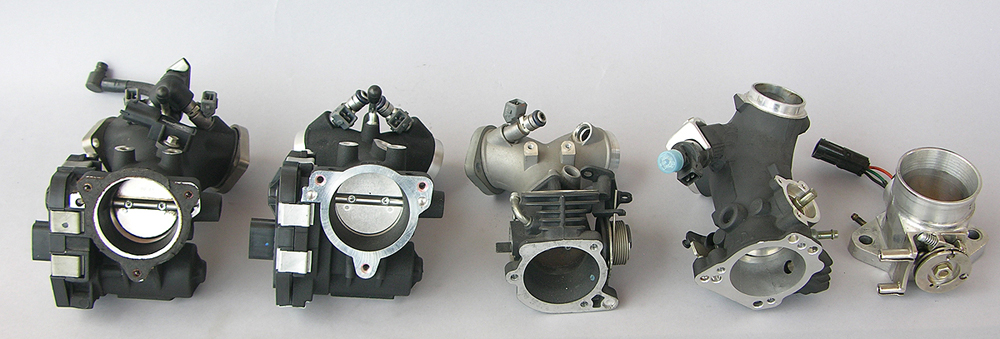
Does get a bit complicated
when you have nearly 40 years of Harleys. We've seen or done it all
from Shovelheads up to the latest bikes.
1. Twin Cam FLT/FLH non-FBW Systems: 2 Bar TMAP Manifold Pressure sensor and two custom fuel Injectors 9.29 grams/second capable of supporting 236 hp at an 80% Duty Cycle. Customer responsible for tuning 0 to 2KPa (2Bar) via TTS MasterTune (see above for TTS costs). Add $395.00
2. Fly-By Wire Systems: 2009 up Twin Cam FLT/FLH Series: Bosch 2 Bar Manifold Pressure sensor and two custom fuel Injectors 9.29 grams/second capable of supporting 236 hp or larger for applications beyond 236 hp. Customer responsible for tuning 0 to 2KPa (2Bar) via TTS MasterTune (see above for manadtory TTS costs). For 2009 and later models with 12mm O2 sensors our exhaust turbo manifolds have both 12mm and 18mm O2 ports. Add $495.00. For applications > 250 hp fuel pump upgrades are required.
Applications beyond 2 Bar
(15 psi) require 12.9 Gram/Sec injectors and a boost referenced
fuel system...This is up to the customer.

3. Scratch Built or Race No EFI Present with 32-2 CPS Flywheels: Pectel SQ6M
controller; Complete Mil-Spec Wiring harness. It does get complex with
traction control, phase anti-phase boost control etc. 8800 programmable
functions. Over 200 man hours in the harness design alone. Injectors up to 2000cc. Only on quote and pre-paid basis.
Here's something to ponder.
Road Toad: Used FLTRI $10,000.00-$12,000. Base Turbo System $8,995.00.
Advanced Cosworth Pectel SQ6M Electronics, including traction control,
data acquisition and complete Mil Spec wiring harness (200 man hours),
plus tuning $25,000.00. Custom Instrumentation $3,000.00 to $5,000.00.
Race prepared 126" S&S SA 126" Turbo engine $15,000.00. Then
there's the race clutch, hydraulic master cylinder conversion, chain
final drive $1,695.00, and all that installation labor $10,000.00.
Figure about $75,000.00 and up. Cheap….and no custom paint or wheels to
attract the uninitiated. No Orange County Choppers, no Jesse James.
4. Some
people want to use other efi systems like ThunderMax or Daytona TwinTec
or some variation of a DynoJet Controller and supply their own injectors.. You are on your own if you
choose this route. Don't ask for help from us. Those companies won't help either...you are the tuner.
3. Shipment of Turbo Kits

Some people in the past
have picked up turbo kits here. Whenever we ship the kits it usually
consumes several days to custom package, control the items, prepare the
parts for shipment, and cart the boxes over for shipment with all the
paperwork (triplicate for international shipment). We used to do this
for free until we woke up. There is a $500.00 charge for the packing and
cartage to a shipper. As stated above: "Shipping charges are paid
for separately by credit card. We negotiate the best shipping prices at
time of shipment." One turbo kit: Three double wall boxes with all parts individually packaged. 76 pounds.
Cosworth Pectel SQ6M Systems Throttle By Wire

These days FBW/TBW is pretty much the way to go and is a critical element in traction control and torque management strategies. The Pectel SQ6M comes standard with traction control and FBW capabilities. We use specialized 60mm Bosch Motorsport units on our Road Toad.
60mm Bosch

FBW/TBW Bosch throttle
body for the SQ6M on the Road Toad.
You have to fabricate this stuff.
Gets expensive. Full fuel bypass. 1050cc, 1300cc, 1700cc, and 2000cc
Injector Dynamics fuel injectors. Expensive Custom Fabrication and
programming.
Chain Drive Swingarm
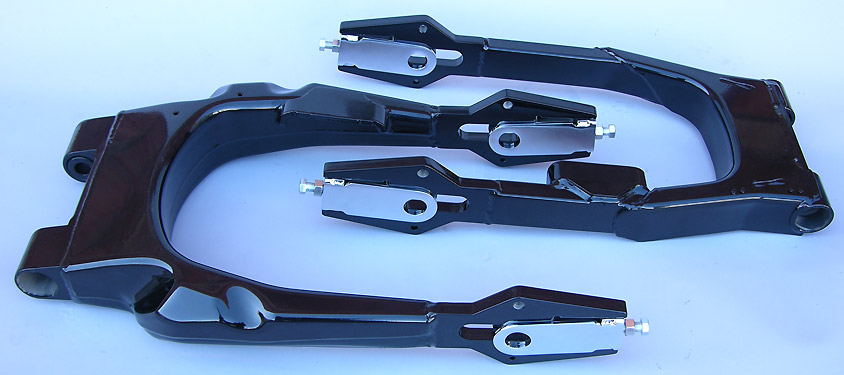
A belt has to know it's limits. As is frequently said, "Chains are for racing...Belts are for holding up your pants". When you start putting in high compression big inch engines, or high output turbos, you are going to start snapping final drive belts. Hayabusas, BMW S1000RR's, or any highly-engineered 180 to 195 hp street bike, would never have a final belt drive. A 140 to 360 hp Harley surely needs one.
We have complete chain drive systems for Dressers.
Does Get Complicated

When you have to deal with
more than 30 years of Harleys you have all sorts of inlet and fuel
systems. We deal with all of them and
even some not pictured. Injector capacity, fuel pump and regulator
capacity. Fuel rail design. Two or three injectors. Stand alone closed
efi system for carbuteted bikes...all the way to high end Cosworth
Pectel SQ6M controllers with specialized Bosch Fly-By-Wire systems. We
have the methodology.
Doc Sweeney's TC88
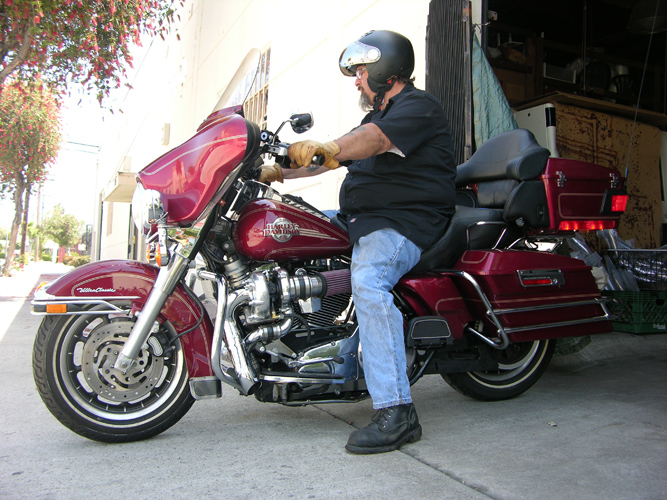
Final road test for Doc
Sweeney's Ultra TC88. Doc Sweeney flies in from Hawaii and rides the
bike to Texas. We upgraded the oil system with an SE Billet Plate and
new pump, put in turbo cams, an SE Race Clutch and fixed all the usual
issues. The bike is a 2005 non-closed loop Delphi ECM. We use TTS
MasterTune and our Dual Air Fuel Ratio Gauge
to tune the bike in real world operation. Oh, we have a 750 hp Superflow CycleDyn eddy current
dyno but the real world is where it's at...cold start, hot start, idle
quality, transitional fueling, steady state cruise at all rpms and, of
course, under boost.. The race plugs have to come out dead clean when
we are finished...i.e. >40 mpg hwy...maybe not cruising @120mph...which we also test.
Besides steady state and
dyno work we easily do 200 miles of instrumented road work.
Doc Sweeney really knows motorcycles. He has his own Motorcycle Museum full of rare early Harley, Indian and other motorcycles. Doc Sweeney cruised from Los Angeles down to the Texas Mexico border without incident save turning up the boost a bit to outrun a few things..then reeled off 28 States in nine days for a total of 5950 miles plus the run from LA to the bottom of Texas. We asked him to hold the boost to 9 psi on his trip but he did a few 12 psi (175hp @ 5500 rpm) test accelerations.
We went nuts trying to tune
his bike initially. It turns out he had, buried in the bike, an
aftermarket intercept box for his efi that kept altering our
programming.
Turbos Down Under
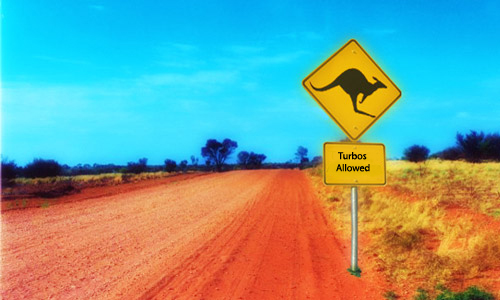
We ship turbos direct to the purchaser without any "exclusive distributor". Turbos are something in our DNA and we don't want parts peddlers messing with them and having you stuck with their exorbinate markups. We won't build a cheap, poorly engineered, and inferior product just to play that game. We race them and we ride them...and make sure they are reliable enough and well engineered enough for you to go coast to coast or across the Outback. Bonneville or Bar to Bar...we've done it.
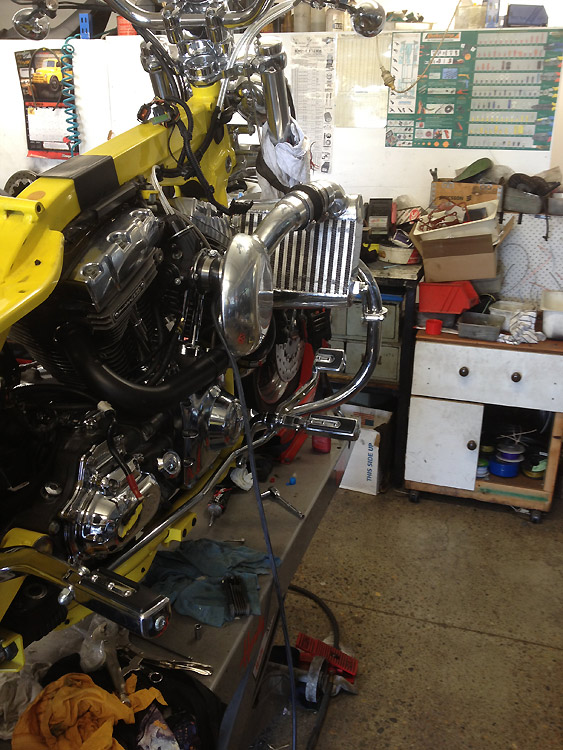
Poetic justice. We shipped a FLT Turbo kit to Australia which is being installed on a 2009 Dyna...not something we have done. We'll see how this works out. The engine has been prepped for the turbo kit. Poetic justice becase a long time ago we sent a turbo kit "Down Under" which got Jeff Richardson at ChopperWorks and bunch of PR for his, at the time, new business. Jeff split the scene years later owing a lot of people money...doing a "Runner" as they say.
Bike produced, in early testing, 200hp and 228 ftlbs of torque @ 11 PSI of boost.
"Who/Why Someone" Should Buy a Turbo
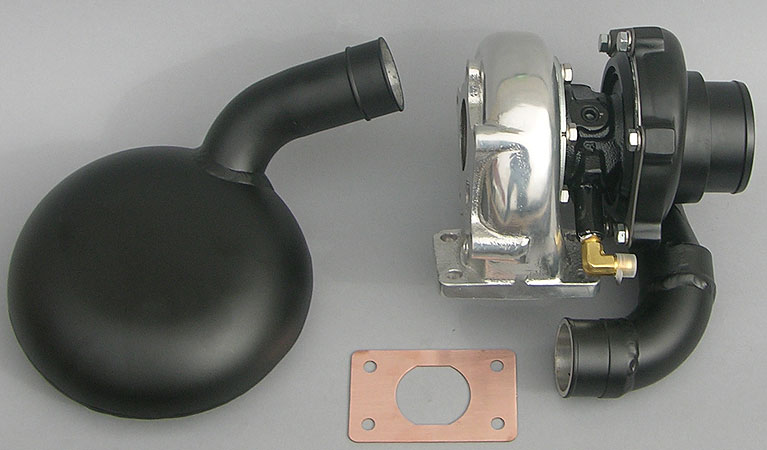
1. You have the money.
2. You probably have some
experience with turbos or understand what they do...and then there is
no choice whatsoever. More power than anything and very civil unlike
overheating big inch engines full of compression. 2x to 3x normal horsepower.
Enough said.
3. You understand that Superchargers, either gear or belt driven, are inferior to Turbos...No we won't explain this to you.
4. You most likely
do the work yourself because you are either cheap, a gearhead, a turbo
fanatic...or you simply don't want others messing with your bike. It is
never a good idea to let anyone else ride your turbo bike. Never.
5. You want to ride and not "Park & Talk" or trailer your bike around to "Shows".
6. People call us up and want us to explain to them "why they should buy our turbo"...If you haven't already pretty much decided turbocharge your bike we really are not going to try to "sell you". You can compare our technology and engineering to anything else out there and decide for yourself. We offer some comparisons of what you get compared to other firms further down this page.
7. There are a certain
percentage of people who will buy these that have zero idea what they
are buying. We try to weed these out...40 years of experience has taught us that.
Stainless Steel Braided Oil Lines

We cover our RB Racing Turbo braided stainless steel oil lines in high temperature shrink tubing. We know you just love to see braided stainless steel lines but they get dirty, scratch everything they rub up against and tend to eat everything they come in contact with. Black is what you get.
Note: We test turbos with
stock Harley-Davidson oil pumps not aftermarket ones. In the case of
aftermarket pumps there my be too much volume or pressure and a
restrictor on the turbo feed line may be necessary. Too much pressure
will cause leakage past the compressor and exhaust seals of the
turbocharger. Our turbos only need 9-30 psi of oil pressure.
Standard Inlet Priority Breather Valve
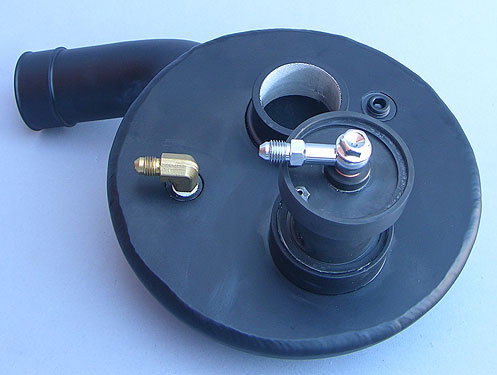
The Priority Breather Valve serves one function: Closing the throttle under boost it allows the boost pressure to vent before the butterfly which keeps turbine speed up during shifts and prevents backflow or "surge" through the compressor. Plenums polished or Black.
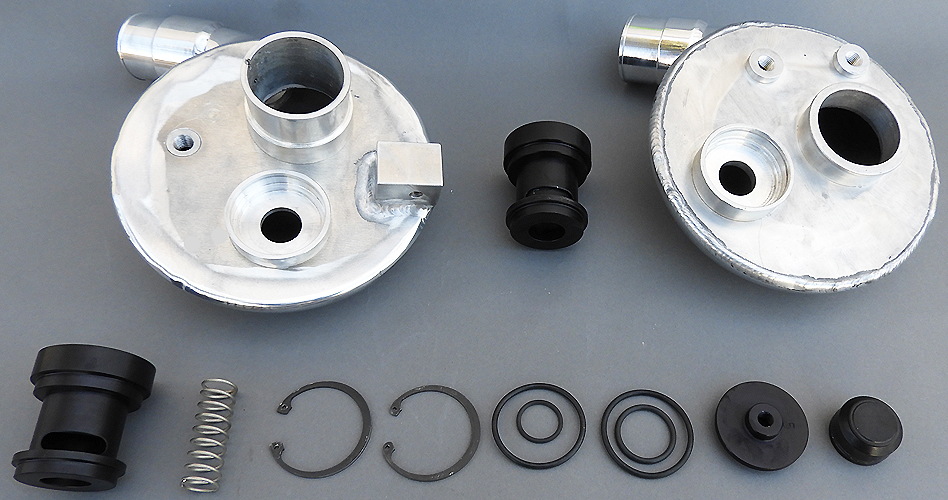
The turbo plenum to the left is for our RSR 2001 EFi System..The turbo plenum to the right is our Cosworth Pectel Fly By Wire plenum.
Both have
sockets for the Priority Breather Valve. RSR has boost and I.A.C ports.
Cosworth has two ports for the programmed Phase-Antiphase wastegate
control.
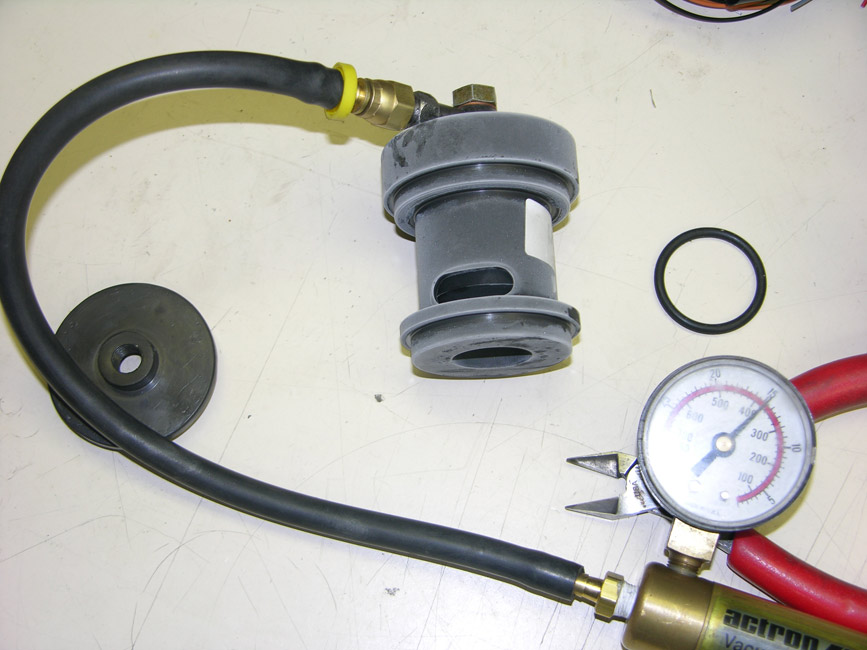
We make our
own and put it in up to four different plenum locations depending on the
engine type..EVO, Twin Cam, ORCA motor, or specialized race system. We
also make our own wastegates. We test these frozen as well as up to 300
Degrees F. These come with our turbo kits but are not sold speparately.
Evos and Twin Cams...Baggers Rule
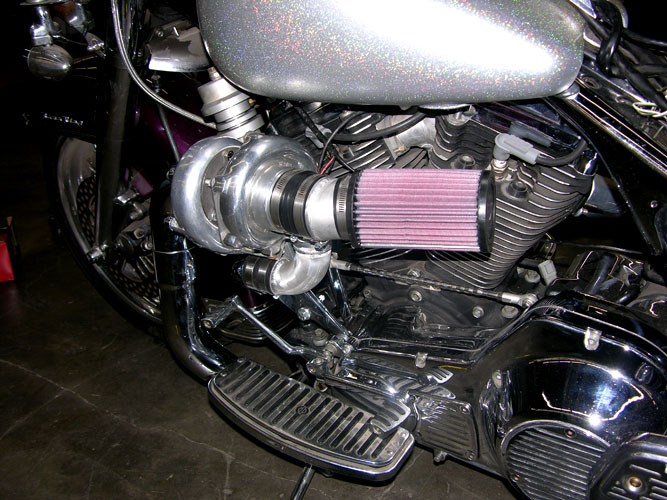
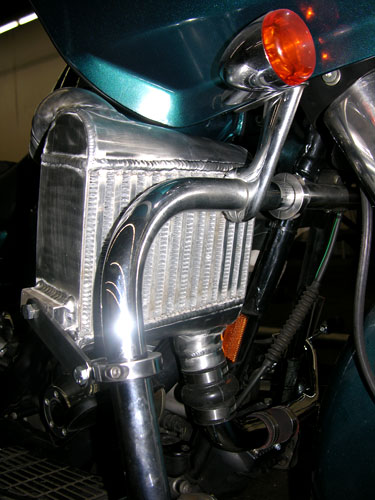
Evo Road Toad..RSR EFI for early carburetted bikes
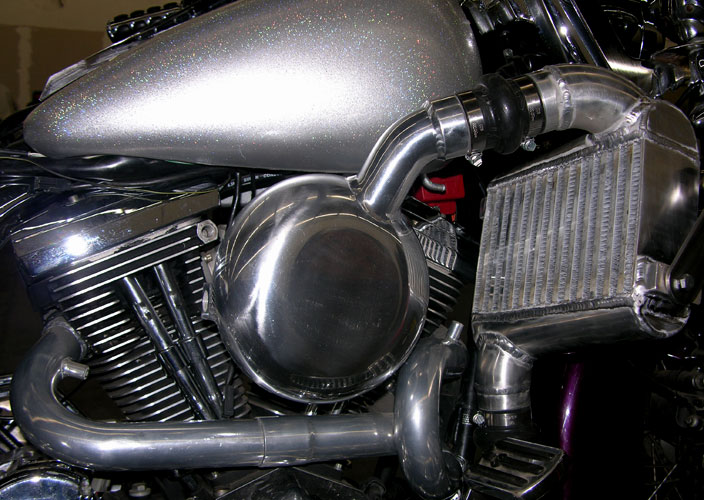
Inlet volume is critical with Harley turbos and even more important with 103/110/120/126/131 big inch motors. Add up the turbo discharge volume from the turbo discharge all the way through the intercooler and into the plenum...It has to be a multiple of the engine displacement for the engine to operate efficiently. Mount the turbo next to the inlet with or without small intercooler and you have a bottleneck built into the system. Two coffee-can sized pistons tugging away at the volume between the compressor wheel and the inlet valve require a stable reservoir of air to work properly. We only do it the right way.
RB Racing uses large 360 hp intercoolers and can employ an optional Priority Breather Valve on the back side of our inlet plenum. The Priority Breather Valve allows the engine to vent pressure when the throttle is closed under boost to prevent compressor surge.
With turbos you can cruise at high speed without boost, roll it on and slingshot past everyone. No need to pump extra air and fuel when you don't need to. If you want to go to kill mode then turn up the dial with your left hand and adjust the horsepower and boost to whatever level it needs to be handle the situation. Normally you leave the boost set at 8-12 psi, short shift at 5 psi, and you can outrun anything you come up against. We use large turbos, not small ones and they pump a lot of air at low pressure ratios. We have a Boost and Airflow Calculator to see what is required.
Take an 850 lb Road Toad and add a couple of hundred horsepower...You get the idea.
Evo Softail Fat Boy Turbo S&S 96" RSR EFI
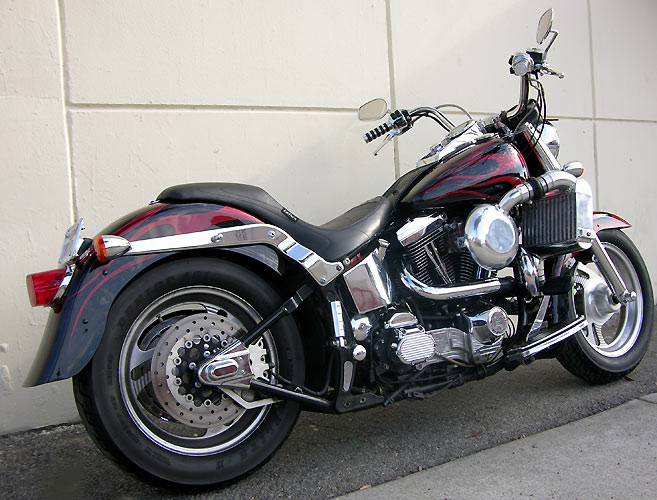
Closed loop RSR Fuel Injection and 96 cubic inches. At 8-10 psi it will handle about anything. Large intercooler keeps things from detonating.
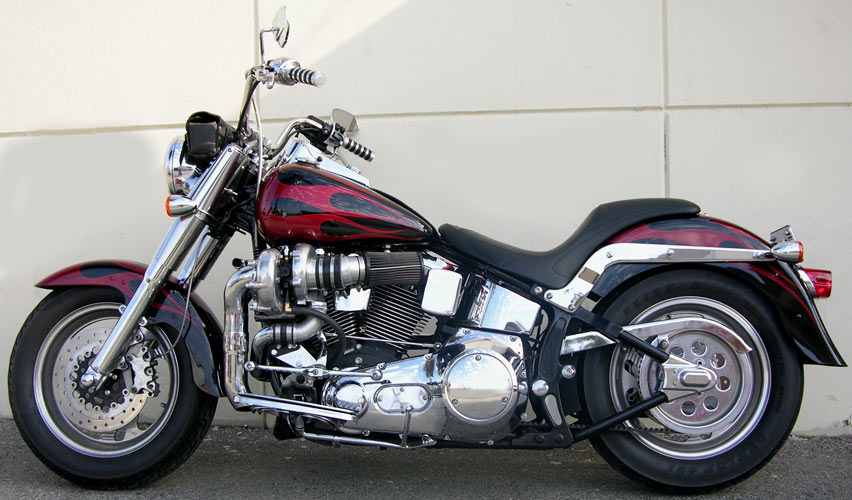
Front exhaust dumps underneath the bike. Turbos are surprisingly quiet in operation. Running closed loop at highway speed these things can get 50 mpg although that's not the main reason you put a turbo on a bike...You do it to whisk past anything that might want to run you, or just to pass a line of semis out on the open road. There is no way you could ever build an engine this civil that can make this much power.
Prototyping for Bullett..600 hp turbo

Pictured is one of our 139" Watercooled Harley Bonneville motors. Intercooled. Fuel Injected. Sort of serious. Well over 400 hp. Here we prototyped the exhaust manifold in mild steel with a special 2" on a 2"radius bend. Next we then made the fixtures and made the part in stainless steel. See the fabrication process involving purging the tubes with argon as they are welded.
We push the limits with these pushrod dinosaurs. How about 212 mph with 9 psi of boost at 4700 rpm in testing at Bonneville?
New Turbo Technical Publication
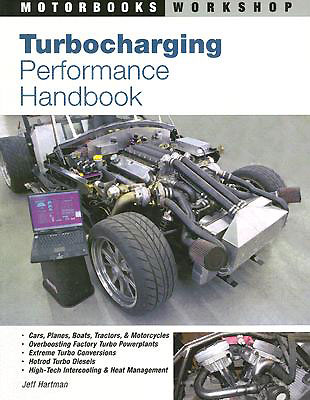
Jeff Hartman's new book features Mike Geokan's 139" ORCA engine on the cover and some pictures of the Bonneville Bullet. Very professional turbo book for those interested in the technology. Jeff covers a myriad of subjects in great detail and explains the math behind turbos, forced induction, and charge cooling.
360 HP Turbos are standard....Black Ceramic or Polished & Ceramic Coated
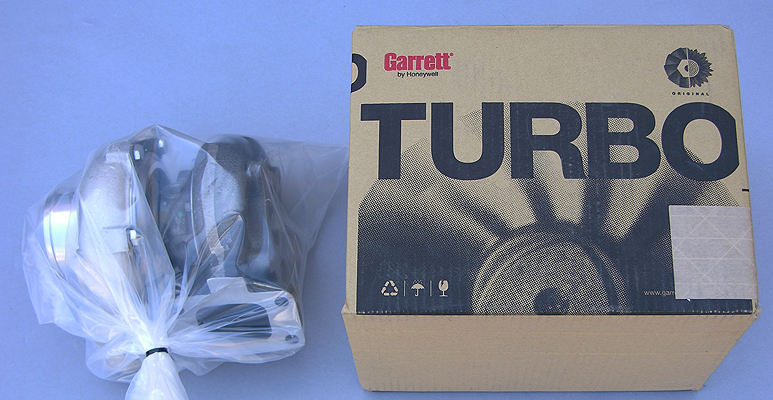
We start
with $1500.00 custom 360 HP Genuine Garrett Ball Bearing turbos with
custom housings before we start modifying them. There is a lot of work
to get them ready.
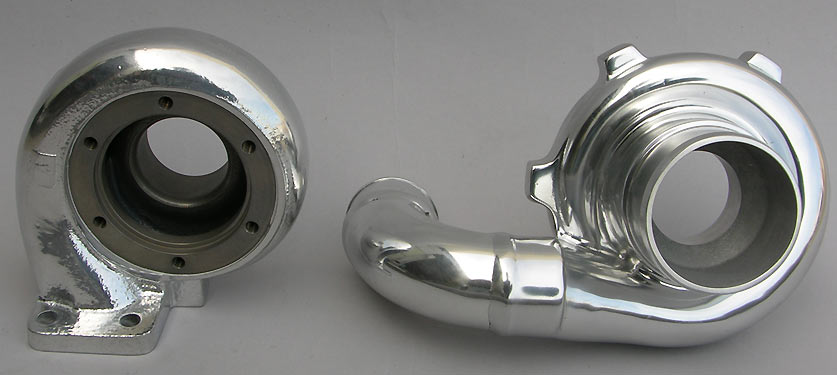
We
spend a lot of time and money to pretty up the turbo and modify it for
the Harleys. Cutting, welding, polishing and ceramic coating
as well as replacing rust-prone hardware with chromed and stainless
steel parts. We also have our aluminum
Intercoolers and Plenums polished and ceramic coated. We do both
Silver and Black Finishes on the turbo housings. Normally ceramic black.
It's
not about "Show Bikes". We could care less about bike shows. For us it
just has to be pretty and stand up to the heat and the elements.
Bonneville is as rough as it gets. All stainless hardware.
Boost and Airflow...Size matters
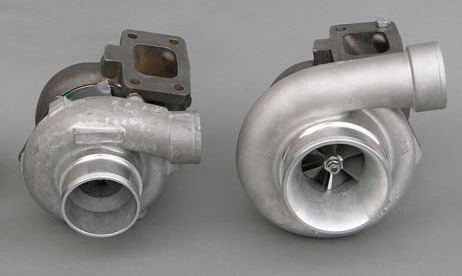
For over 30 years people have been asking us about "Boost". We prefer to talk about CFM at a given pressure ratio in relation to engine size and rpm...of course the conversation gets completely lost at that point. People only want to talk about how much boost they can run. Take the large turbo on the right at 8 psi and compare it with 8 psi from the smaller turbo on the left...Guess which one has more CFM at 8 psi or a 1.5 pressure ratio... If you guessed the bigger turbo you would be correct. RB Racing uses large turbos that move a lot of air at low pressure ratios so you don't have to twist your engine so hard to make the horsepower. The power is instantaneous with no lag.
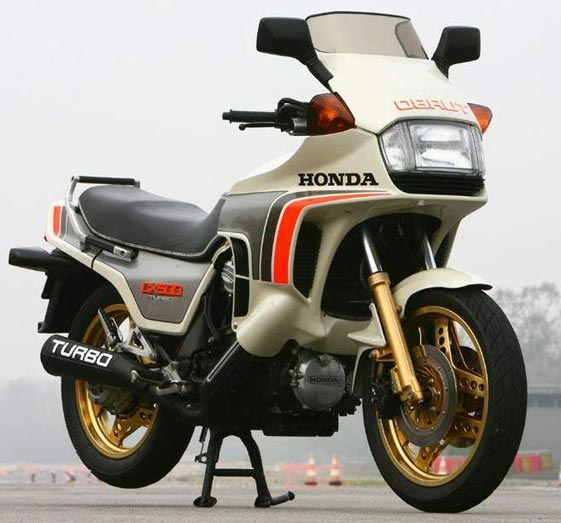
Think about Honda's CX500 Turbo that was introduced 30+ years ago in 1981. It ran 19 pounds of boost on a 30 cubic inch engine and made 82 horsepower. Small engine, very small IHI Turbo. There's your 19 pounds of boost and 82 horsepower. RB Racing uses large turbos that make a lot of horsepower at low boost levels and astounding power at higher boost levels. Size does matter. We do not use cheap $600.00 small turbos like other turbo vendors use.
Screaming Eagle Super Tuner...SEST (discontinued)
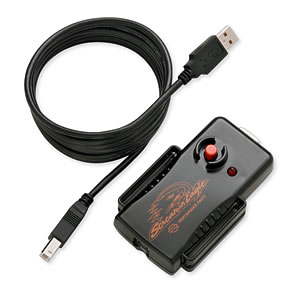
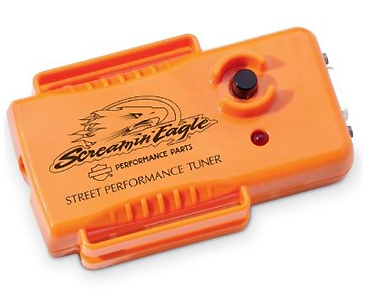
"SEST" or Greek for the worst written instruction manual we've ever seen. We defy you to figure out how to get various charts and graphs to open and how to get to the advanced versus basic tuning options. We suggest you look around the internet as the manual is of little help.
We bought one of these to see what was involved. If you can figure out the software navigation issues and install a map that somewhat matches your bike, you simply ride around, observe the RSR Air Fuel Ratio Meter display and make edits. The tuning is fairly straight forward. Without the Dual Gauge we don't know how you would do it. We just ride.
These have been discontinued.
Steve Cole's TTS MasterTune
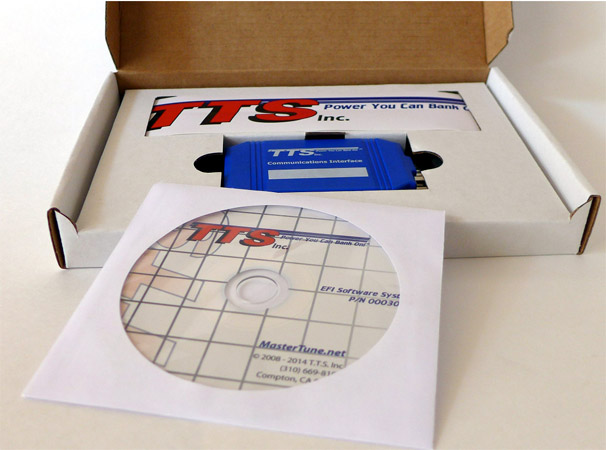
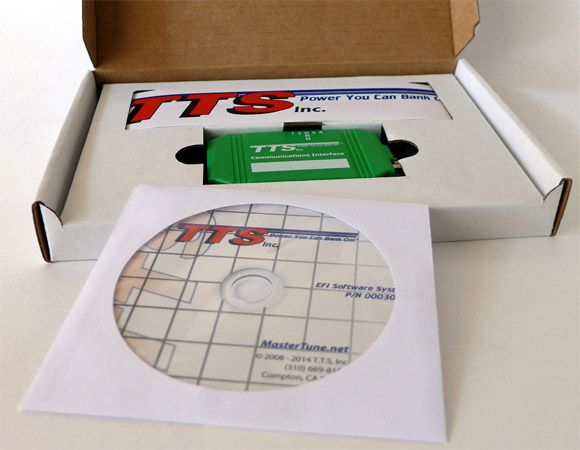
Before the Screaming Eagle Super Tuner (SEST)
there was the SERT or Screaming Eagle Race Tuner. Acronyms, what would
we do without them? Steve Cole
was the guy behind the SERT until Harley decided to go with another
contractor. Money. It's always about the money. Since Steve designed
the original stuff, this new stuff i.e. TTS MasterTune is easier
to use and has one benefit that the "SEST" does not have...You have the
ability to save and restore your original calibration. In addition with
the Green Analog Interface Model you can log up to four analog channels
like Wideband Sensors.
We prefer software solutions to tuning late model efi Harleys and not use any add-on boxes or to replace the entire system with some "self-tuning", throttle-angle based, wide band controller. There are simply too many problems technical-wise with wide band sensors...Stuff they do not tell you about like pressure and temperature compensation issues and sensor latency. You are better off with the OEM O2 sensors. You won't believe this but that's your problem.
One point no one is going to tell you is that Harley has hidden tables that will richen up your injectors if you hold the bike under load, like on a dyno or wide open throttle for any amount of time beyond "x". They don't want you to fool with this. Guess what happens to those people who tune under full load.
We've used
both the SEST and the TTS Master Tune. Both work about the same with both based on VE Tables. The
TTS MasterTune is a more friendly system and has more features.
USB
Tuning cables must be purchased separately. Three versions are
available: Specify Cable Number when ordering.
(1) Part # 2000014: 4 Pin J1850 (older bikes). $42.50 list price.
(2)
Part # 2000011: CAN 6 Pin Cable Kit (newest bikes). $42.50 list price.
(3)
Part # 2000014A: 2014 Touring models Only. CAN 6 Pin (have different pin allocations). $42.50 list price.
The Total Cost for a single bike TTS Master Tune (Blue) is $445.00 (tuner no cable). The Total Cost for a TTS Master Tune (Blue) Two Bike Programmer is $645.00 (Tuner no cable).
The Total Cost for a single bike TTS Master Tune (Green) is $595.00 (tuner no cable).
A PDF Tuner Guide explains the operation of the TTS software.
Tales of Woe...Poor Packaging and Engineering
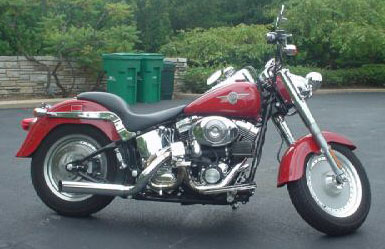
Anyone who hangs a turbo on the right side of your big twin and blows it directly into your inlet manifold without an intercooler is an idiot...we won't go into the reasons why. There are still several cavemen doing it this way. The bike pictured was offed on E-Bay after the owner dumped $11,500.00 into trying to make it work. Nothing fit, nothing worked, and it was a total disaster. The owner called us up several times and was really pissed off about ever getting involved in the deal. He spent $5,500.00 for a few ill-fitting tubes and a turbo...and another $6,000.00 in shop time trying to re-engineer the disaster. We spend a bit of time listening to these tales of "woe and no go".
Why spend all that money if a normally aspirated engine is faster. Hey...some people want a turbo and there are people who found out you can put $2,000.00 worth of parts and labor together and sell it to you for $5,500.00. Born every minute as they say.
The usual story is: " Nothing fit. The things that fit broke. My motor broke virtually every time I rode it. The manufacturer worked on it three times...I finally took it to my Harley dealer to fix the motor etc, etc." We listen to this and simply tell the people..."You wanted a turbo and you got one i.e. a few tubes and a turbo". There is a lot more to it than that. This isn't plumbing.
We've been asked a few times each year
to straighten out these messes and we have, from time to time, offered
a bit of help but, in the end, it's simply better to throw it all out
and start all over...Of course by then the customer has already spent
all his money. Recently we were leaving for Bonneville where we set a
200 mph record and got a call from a Harley Dealer who was trying to
save a turbo project for a customer...We made them an AIC 400 aditional
injector controller and delivered it to Bonneville...of course they did
not use it and the motor croaked...and the other vendor's turbo kit
self-destructed with the header spyder-webbing and cracking into many
pieces. The guy wanted a turbo. Someone sold him a "turbo". The dealer
and mechanics tried to save the project...end result...damaged motor
and a turbo kit that self destructed. Doubt they have the money or will
to do it again.
This is dumbass engineering at its worst. Designs like these are worse than we did almost 25 years ago with Shovelheads. They will quote you big numbers but the designs are so limited the real world catches up with you quickly. Don't try to go racing at the track unless you want to get embarrassed by some guy running an S&S carburetor and no turbo.
We would go to the dragstrip with Carl
Pelletier and work on his Top Fuel Harley and see turbo street Harleys
running high 11's. Get real. The first drag racing turbo Harly we made
ran 7's out of the box.
Comparison...There isn't any
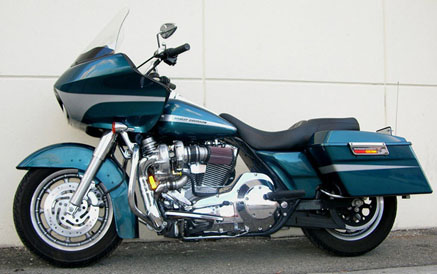
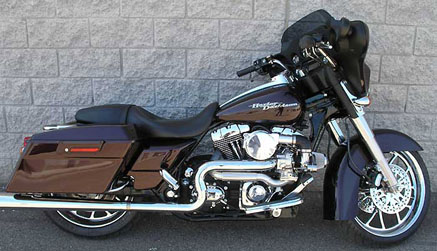
|
Items
|
RB Racing
|
Others
|
| Turbocharger | $1,500.00 Garrett 360 Hp Ceramic Ball Bearing Turbo with Custom Housings. Highly modified |
$600.00 Small Turbo. Not modified. |
| Intercooler | Standard: Large Ceramic Coated 360 hp rated Intercooler | None, or optional for $695.00 a 100 hp Ineffective Small
Intercooler. Restricts airflow. |
| Exhaust Manifold | Independent,
dual slip joint, with Merge Collector. Does not support Turbo. Turbo
supported independently by laser cut steel supports. No stress on exhaust port studs. |
Log manifold, non-merge collector. Exhaust pulses face each other. Exhaust port studs support turbo weight. |
| Fuel Control EFi models |
2 Bar (15 psi) or 3 Bar MAP Sensor. RSR AIC400 Pre-programmed 3rd Injector Controller. Stock Injectors remain. Or: Special Bosch Racing Injectors for 236 to 300+Hp. TTS Master Tune w/ 3Bar Sensor Or: Customer may choose to use an aftermaket Fuel Controller. In this case tuning and integration is left up to the customer Or: Complete revision with Cosworth SQ6M Electronics. |
None. You are supposed to buy some aftermaker intercept box, or another ECU for $900.00...or do nothing. |
| Boost Control | RSR Billet Boost Master Wastegate with boost pneumatically
controlled from the handlebars. 8 to 25 PSI while riding |
Integral flapper valve wastegate. Wrench adjust, limited
control. Not adjustable by rider. 8 psi. |
| Fuel Control Non-EFi applications | RSR Closed Loop Fuel Injection System controlling up to 500
horsepower. Cosworth Pectel SQ6M |
None or use carburetor. |
| Inlet Priority Breather Valve | Standard: Allows both venting of boost pressure under closing butterfly for improved
response and preventing compressor surge |
None offered. |
| Gas Tank Modifications | None for 250 HP Blackbird Systems. For 360 HP Pro Street Systems new high output external fuel pump, filter, regulator and petcock assembly. |
Must
disassemble gas tank and install plastic vacuum boost line modification
to oem regulator. Chincy, stupid. No options for high output except to
switch to
carburetion. No specialized fuel system. |
| Oil System | Positive Oil Scavenge | Simple Oil Drain to Cam Cover |
| Water Methanol Injection | Optional: 1000 psi system |
None Offered |
| Digital Turbo Instrumentation | Optional: Orca Turbo Dash: Dual EGT probes; 30" Hg to 30 PSI;
L.E.D. Instrumentation Cosworth ICD Dash. |
None Offered |
| Inlet Air Cleaner |
360 Hp rated K&N Turbo Air
Cleaner |
Small, restrictive, single carb
type air cleaner. They can't use a larger air clraner as it will run into the front fender when you turn the handlebars. |
| Turbo Tail |
2.5" Non restricted exit. Well
clear of legs with integral wastegate exit. Quiet. |
Turbo exit routed under your
leg. Long restrictive sections. |
| Air Fuel Ratio Display Memory Boost Gauge |
Real time digital display with RSR Dual Air Fuel Ratio Gauge Glycerin Filled 0-30 Psi with Memory |
None Offered. No Boost gauge. |
Intercoolers..Size Matters

With our newer 360 HP turbos the power went up so the charge cooling had to keep pace. In the center is one of our old designs from the 1990's flanked by a couple of larger cores. The smaller intercooler was only rated for 150 hp. These two black intercoolers were made for a client long, long, ago, who decided the bike building business wasn't all it was cracked up to be...no money, so we kept them. Later on we just cut them up for scrap.We only use larger intercooler cores rated for 360 hp.
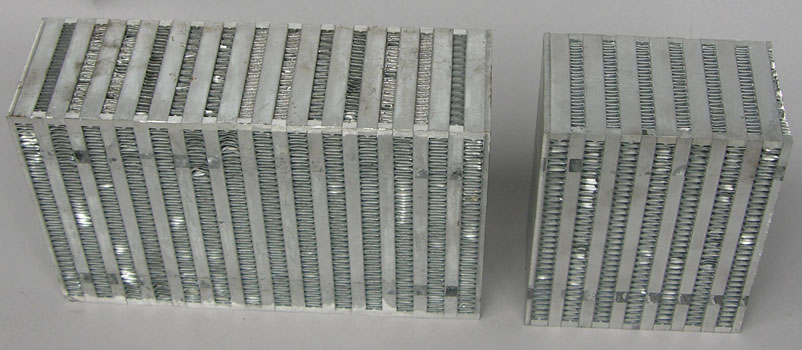
We use large intercooler cores rated for 360 hp with 13 passages for the compressed air and 14 passages for air cooling. In our designs we place the 14 passages directly in the oncoming airstream for maximum cooling. Run 25 pounds of boost and your charge temperature approaches 300 degrees F. If you cut the core in half your horsepower potential and cooling are severely compromised.
Click on photos to enlarge...Our Older Intercooler design Late 90's
Pictured above is one of our RSR Closed Loop EFI Intercooled designs from the late 1990's. We were running intercoolers four times as large as this on drag racing applications and more than twice as large on our 1990's Bonneville bikes. This smaller intercooler was designed to drop inlet temperatures about 75 degrees F at low boost levels...It was not designed for higher output because there was too much of a pressure drop.
Poseurs..Ineffective or Silly
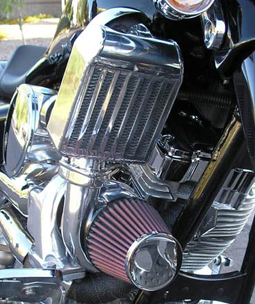
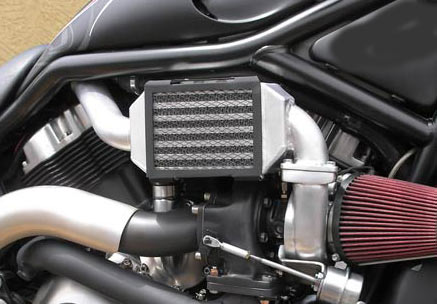
Other
companies seem to have copied our smaller 1990's intercooler design and
location, only they use an even smaller intercooler. In some cases they
even turn their intercooler sideways to the airstream which pretty much
negates its purpose. Hey, it's something to sell. It doesn't do crap
and causes a pressure drop to boot. We have no idea how the air is
supposed to flow through the bottom of the intercooler on the above
left. The manufacturer claims a 30 degree F drop....All we see is a
restriction. These poor designs don't do shit.
In case you didn't realize it, compressing air (boost) makes it hotter. The hotter it is going into your engine the more prone your engine is to detonation. At higher race levels the compressed air can reach 300 degrees F. Employing a larger intercooler allows us to drop charge temperatures 75 Deg at lower boost levels and 150 Deg F at higher boost levels. Combined with our 1000 psi RSR Water Injection you will make more power without engine destroying detonation.
Those air cleaners pictured above are 1/4 of what you would put on a Japanese inline four.
Vacuum Cleaner
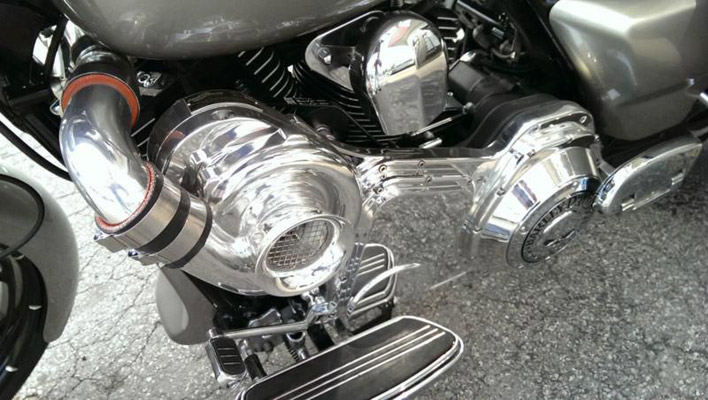
Suck
unfiltered air on one side then blow it through and air cleaner on the
other side. Must be a Dyson design. These are typically setup with a
very small charge cooler on the right side and have drive ratios that
give you a 30 to 50% increase in horsepower. You might as well put in a
higher compression bigger motor. 124's with B2/B3 heads typically make
145 to 150HP.
Actually,
this is a belt driven supercharger and not a Dyson. It forces more air
into the motor directly related to engine RPM and not to load like a
turbocharger. On our turbos you can cruise at high cruising speed and
not be under boost and then instantly go to whatever you have the
wastegate set at, say anywhere from 8 to 25 psi. 8 PSI is what these
Supercharger setups typically run at higher rpms.
RB Racing EVO and Twin Cam Intercooler

We're sort of specialized in Road Glides or "Road Toads" as we call them because they are one of the best bikes Harley has made aside from the FXR. Fun to outrun everything you come up against. Here's our charge cooler solidly mounted on the Twin Cam Road Toad FLTRI crash bar. We mount the turbo solidly to the engine with thick 3/8" laser cut steel plates. Silicone expansion joints allow the turbo and inlet plenum to move while the intercooler stays locked to the chassis.
Every once in awhile a customer will call and want us to build a turbo without an intercooler. We generally reply that "If you don't understand that a turbo compresses the air, and that as you compress the air it gets hotter, and that the compression stroke in the engine compounds this temperature rise, then you should not be getting a turbo." We don't think you'd be riding your bike around if it was a 150 to 300 degree Fahrenheit day outside.
We
first put larger intercoolers on Evolution Baggers in the early 1990's.
Pulling a constant boost over the infamous "I-5 Grapevine" the inlet
plenum would roast your leg without the intercooler...With the
intercooler it was barely warm to the touch. In short, we don't make
turbos without intercoolers. We can run around with 8psi of boost,
outrun anything, and the intercooler remains cool, and so does your
inlet air.
EVO Turbo...1998 Road King

We mount our turbos on the left side and route our exhaust down out a large 2.5" dump tube. The wastegate dumps directly into the 2.5" dump tube. No exhausts or turbos run inside your legs. The turbocharger is solidly mounted to the engine and uses silicone rubber isolated couplers to go to the intercooler and from the intercooler to the plenum. Professional quality parts.
We use air filters that will flow enough for the 3" turbocharger entry. The front facing small air filters you see on other turbo kits are a joke. The RB Racing Boost Master wastegate is pneumatically controlled from the handlebars. You can turn up or down the boost while you are riding. We do not use cheap integral wastegates.
500 HP Bullet Intercooler

Twin core charge cooler for Mike Geokan's Bonneville Bullett pictured above with rubber isolation mounts top and bottom. Two 3.5 x 6 x 9 Intercooler cores for 500 hp. You can see from this and other photos that Mike Geokan solidly mounted the turbo to the two thick aluminum plates. On the Bullett, just like on our street kits, the turbo is mounted independently from the exhaust and the exhaust has slip joints to prevent cracking. Hanging 20+ pounds of turbo and exhaust on a shaking engine, supported only by the exhaust tubes themselves is a bad idea.
To see what happens when you compress air check this out. Of course, if you were holding on to your bicycle pump a long time ago you are well aware of what happens. Turbos are really good at heating things up and intercoolers are really good at getting things back to normal. We only use intercooler cores designed for 360 horsepower.
Not Needed
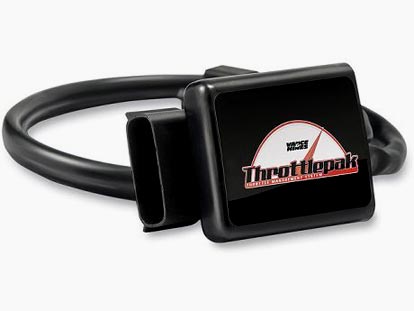
If you have a late model FL with a Fly By Wire throttle do not use the above device with our turbocharger systems. We suggest you get Steve Cole's TTS MasterTune software described earlier on this page. When purchased with the Turbocharger we offer a $50.00 discount i.e. $375.00 v $425.00 list. TTS MasterTune allows you to adjust your electronic throttle without the expense of the V&H device as well as everything else in the Delphi ECU.
Water Injection Option
Hard anodized water injection reservoirs with our integral 1000 psi water injection pump. Sophisticated two stage RSR Water Injection is standard with our kits. Even with large capacity intercooling you need to reduce inlet temperatures and increase charge density to keep your motor alive and to keep you in front of anything you come up against.
We now are now offering Water Injection for all Turbo Kits and ORCA Turbo motors. We have always run water injection on our Bonneville bikes and since people always want more power, water injection is the only safe method of running more boost. Our new RSR Water Injection Calculator shows you how it works.
We only do it the right way. There is no other way. The way we do it at Bonneville.
Cosworth Pectel EFI and 250 to 360 hp Fuel Peripherals
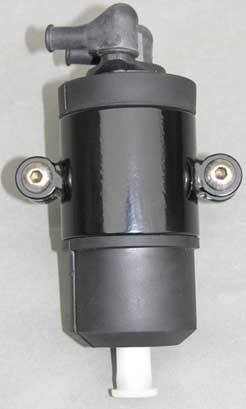
We don't want you going into your fuel tank and messing with your oem fuel pump and regulator as long as you want to run under 200 hp. No running of boost lines into your fuel tank and drilling holes in your oem fuel regulator. The oem pump is ok for most of what your will do unless you want to run 250 to 300 hp. Then we have to change things.
For our turbo motors and high output Pro Street Delphi systems details like fuel pumps are a bit of an issue as the stock pumps simply do not have the flow necessary. We have sorted through various suppliers looking for the best pumps for our applications. Some were smaller than others, which was a plus, but the quality varied and formed metal nipples or plastic casings could crack...and some had shitty push-on blade connectors that, while they worked, were questionable. Water proofing these tended to be a hassle if the pump was mounted externally.
Pumps have to be of very high quality and are typically rated for about 3,500 to 5,000 hours life...assuming you don’t try to pump even microscopic grit through them...and if you don’t run them dry. We sorted though many manufacturers and tend to use pumps that have a German accent...pumps which have weather seals on the connectors, screw-on terminals, banjo fittings, and a distinct lack molded plastic parts. We make sure you filter the gas before it gets to these expensive items.
Powder coated mounts for external wounting, rubber isolated and stainless steel hardware. Different pumps for different horsepower ratings. The German pumps we use are static @ 400hp and 550hp....We like to see at least 30% bypass fuel at peak numbers so we use these pumps for applications up to 307.7 hp and 423hp respectively.
For larger applications, like the Bonneville Bullett, we use larger 1000 hp pumps and regulators from SX Performance.
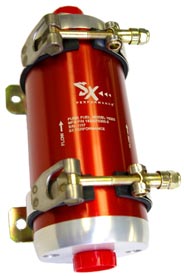

These 1000 horsepower rated units allow the use of 600+ hp capable turbochargers and remove restrictions that would occur in regulators with less bypass area. It all gets expensive. The pumps are $346.95 and the regulators are $149.95. Then you get to go buy some expensive pretty fittings and large hoses to complete the ensemble. We run large AN10 lines on the Bullett.
Big Air...RSR Closed
Loop EFI...Non
Delphi (Discontinued)
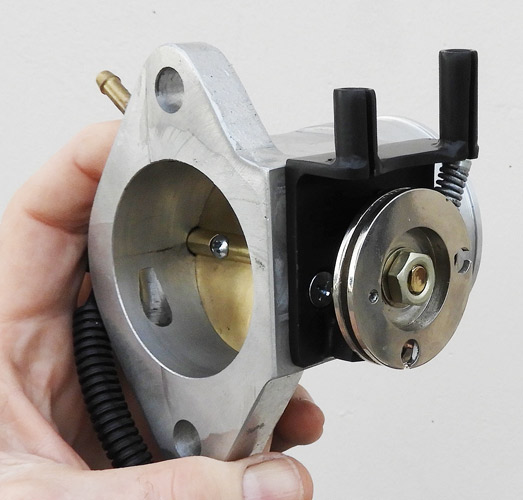
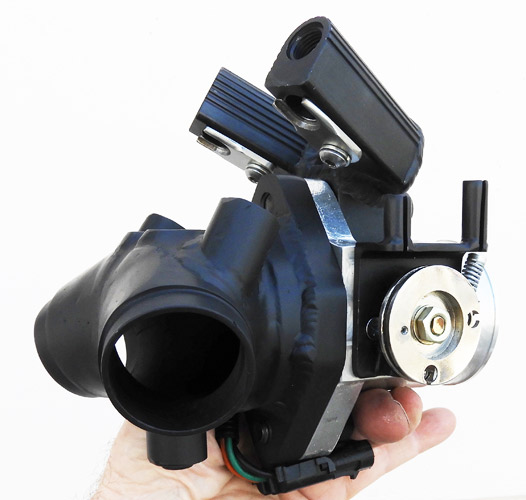
Note: Everything is
Fly-By-Wire these days so we are discontinuing the above after more
than 28 years of maching castings, butterflies and shafts as well other
items.
We have a completely integrated inlet system with a 56mm (2 3/16") throttle body with integral stepper motor Idle By-Pass, and ball bearing shaft support with shaft seals. Combine this with a full 1/2" fuel by-pass fuel rail and port injection in either 2 bar or 3 bar systems with up to 6400cc/min delivery capability and you have the ultimate turbo package. Fully engineered and proven.
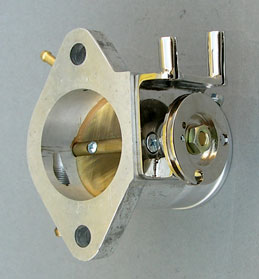
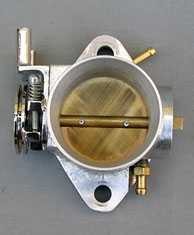

The throttle body incorporates push pull cables, screw adjustable idle stop, vacuum/boost port, TPS mount, Idle Air Bypass circuit, and a two bolt flange using 7/16" Allen Bolts that hold the fuel rail and throttle body to the inlet manifold. The TPS is bolt-on and forget. There is no need to "set" it. The throttle shaft rides in sealed ball bearings.


Here is a system with our RSR EFI set up with two (2) 650cc Bosch EV6 Injectors in a 2 Bar system for an 80" EVO motor programmed for 195hp @15 PSI.
Killer Wire...RSR
Closed Loop EFI (Discontinued)
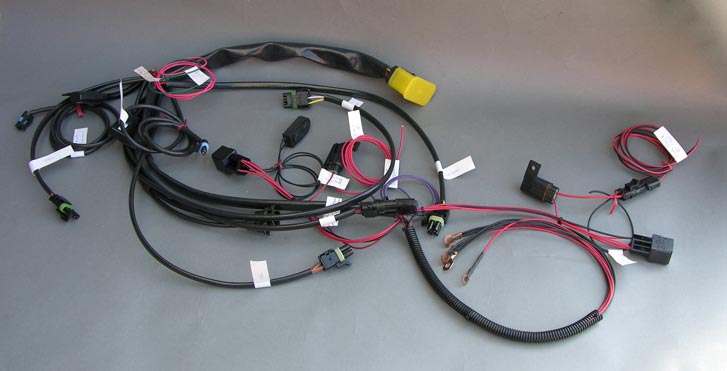
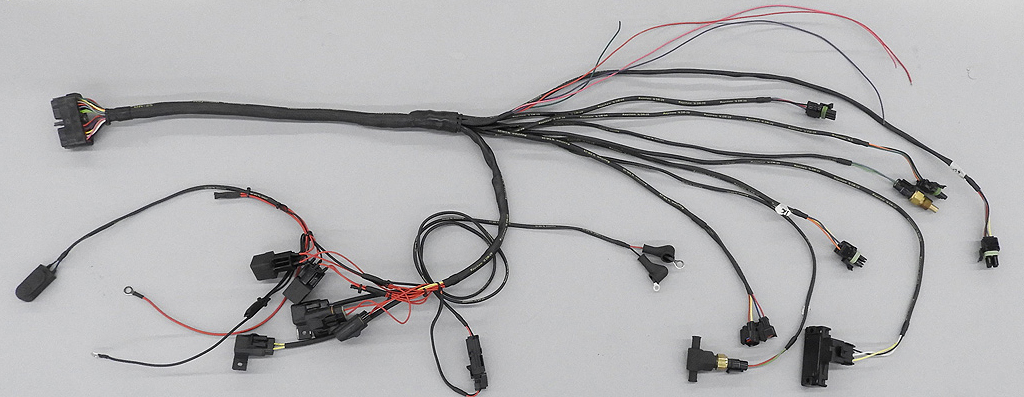
Later on we switched to Raychem DR-25 coverings sealed with Raychem SCL and Resintech RT125 Epoxy.
Water-proof, abrasion -proof, Harley-proof wiring. Never a wiring failure since we started doing them in 1989. Automotive grade high temperature wiring with waterproof connectors, gold plated and silicone sealed Deutsch ECU 40 pin connector, Weatherpack silicone sealed sensors, and fused peripherals, all sheathed for abraision. Very professional. There is also a waterproof tuning switch that allows programming with the ignition "off".

One of the
last RSR Closed Loop Fuel Injection Harley Turbo Kits being
shipped....What you see is 30 years of development. In 1990 there was
nothing remotely like it and these systems went on to set Bonneville
Land Speed Records and win Drag Racing Championships.
This one is
headed for an 80" EVO Dresser...The RSR EFI is pre-programmed for 195HP
in a 2 Bar (15 PSI) system. These systems shipped complete with a
laptop, software and tuning cable . Time to move on to more
sophisticated Cosworth Pectel engine control systems for Scratch Built
ORCA EVO Motors that we have been developing for a number of years. Our
Twin Cam Delphi systems remain the same in either 2 or 3 Bar
configurations.
Optional: Orca Turbo Dash
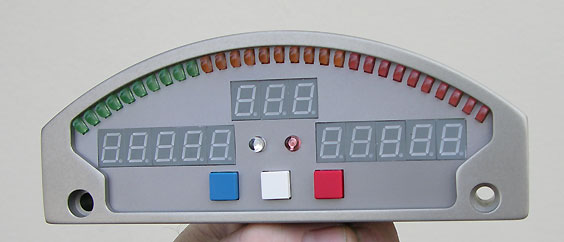
We got sick and tired of non-zeroing, non-lighted, leaking, liquid-filled boost gages and lighted mechanical gauges that have needles that vibrate off, so we made our own. The result is the Orca Turbo Dash, a sophisticated machined from billet dash that displays 30" Hg to 30 psi (3Bar) as well as dual egt displays (Deg C or F selectable) and RSR Water Injection activation L.E.D.s.
Optional but suggested for all RB racing Turbo Systems it allows you to monitor and record boost and exhaust gas temperatures as well as provide alerts for staged water injection activation. Blue button is high recall for boost and egts. White button is a display dimmer for night operation. Red button is to reset high memory recall.
Mechanical Boost Gauge
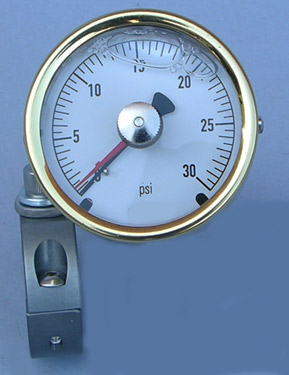
3 Bar Boost Gauge with Tattle-Tale indicator showing maximum boost actually run. Glycerin filled to resist vibration. Easy to reset, even with gloved hand. Not lighted. If you do not order the ORCA Turbo Dash you must order this part.
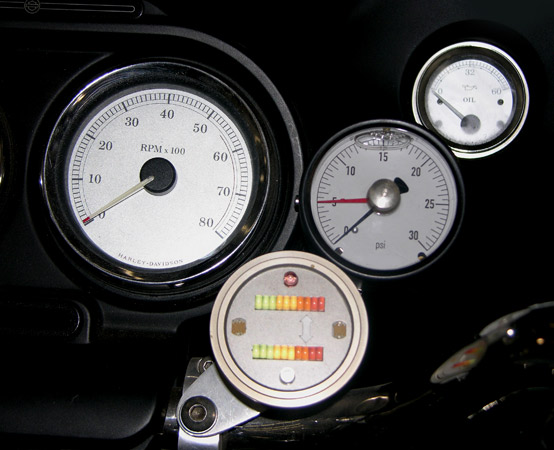
Part Number 03-1013 $149.50. Center back mount w/12mm x 1.5 locknut and integral push-on hose nipple. On sequentially injected Harleys we mount this gauge directly off of the back of our RSR Dual Air Fuel Ratio Gauge. Viewing the tach, the air fuel ratio, and the boost all in one location. Only O2 feedback is fast enough for real-time monitoring.
Boost Master Wastegates
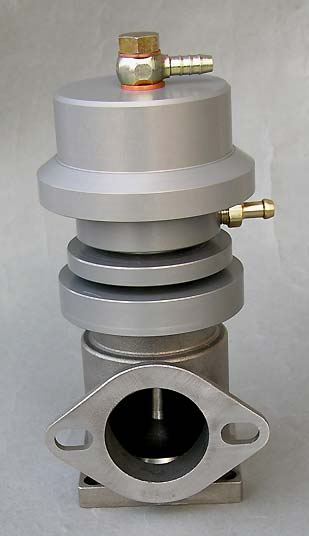
We make the best wastegate that can be bought. Boost Master. Investment cast stainless steel valve body and CNC aluminum construction with capacity for 500hp. We do not use cheap integral wategates that are either non-adjustable or require wrenches to do so. We only use rider adjustable, pneumatically controlled, wastegates. You dial the power up or down while you are riding.
Boost Control and Fuel Programming


Black Knob controls the boost. Clockwise increases the boost. Turn the boost
all the way off (full counter-clockwise) and it's about 6-7 PSI. For
very high boost levels like on our Pro Street Kits we require you
upgrade your fuel pump and regulator system. Just remember, at 8 psi,
you can outrun about anything. When you're cruising at 75 mph and roll
the throttle on it will instantly produce boost pressure. Rider
adjustable when you are riding. 6-7 PSI to 25 PSI.
Dual RSR Air Fuel Ratio Gauge is to the right. We have no idea how anyone thinks they are going to get their programming right without actually riding and observing the Dual O2 Display. The O2 Display is a mandatory purchase with the kit. For instance, our Turbo with some higher end, higher lift cams, pulls 10" Hg. in a high speed (80 mph) cruise on level ground. Barely nudge the throttle and it goes to 5" Hg and anymore than that and it goes directly into boost. Hit a long steep grade at high speed and the turbo will hold at about 2 psi boost. These figures are way more air and manifold pressure than you are used to programming for and it's not a good idea to beat your bike to death on a dyno, especially with a turbo. Best to ride.
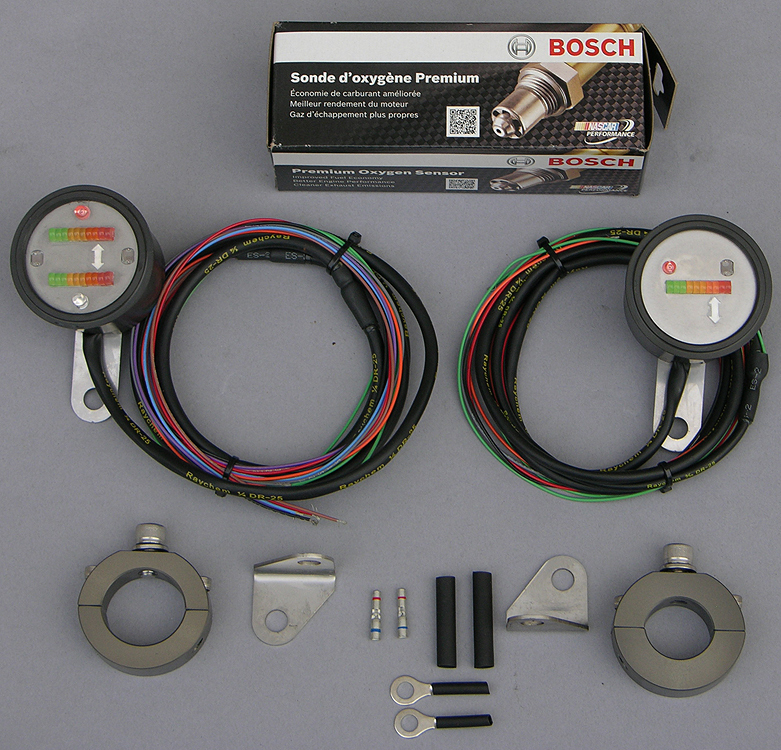
Single or Dual RSR Air Fuel Ratio gauges. Dual if sequential fuel injection.
Programming the Delphi Controller with a SEST or TTS MasterTune you want to run near 14.7:1 at your light cruise settings for maximum economy. We run Race Plugs on the street and they are dead clean with a white porcelain. The "maps" or "VE" tables slope up quickly past 10% throttle unlike stock programming. Using the Dual Air Fuel Ratio Gauge you can quickly get all transitions and F/R fueling correct...In the Real World.
FLT/FLH Rear Wheel Steering
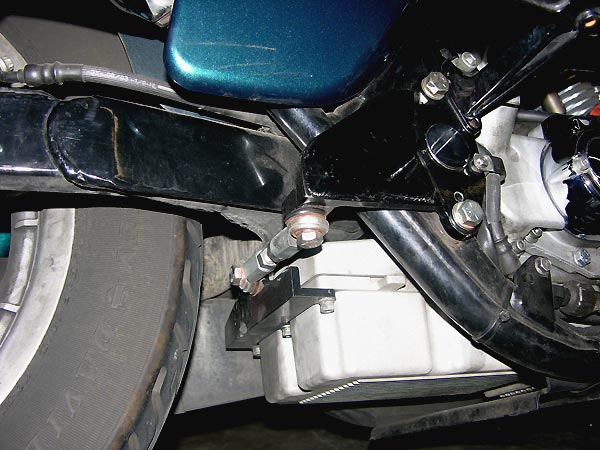
When you go turbo on your pre 2009 Bagger you need to tame the rear flexi-flyer engine transmission swingarm combo. There are several people making stabilizers for the FLT/FLH series. We don't have any opinion on who what when where or how is "better". We bought this one off of E-Bay for $50.00 as opposed to the usual $400.00. It seemed to have decent ground clearance. At 8-12 psi the Road Toad gets really serious and the turns come up very quickly. Stabilizer or no stabilizer don't slam the throttle shut in a high speed sweeper.
V-Rod Turbos...
Note: These are high compression 11.5:1 motors. Compression must be reduced.
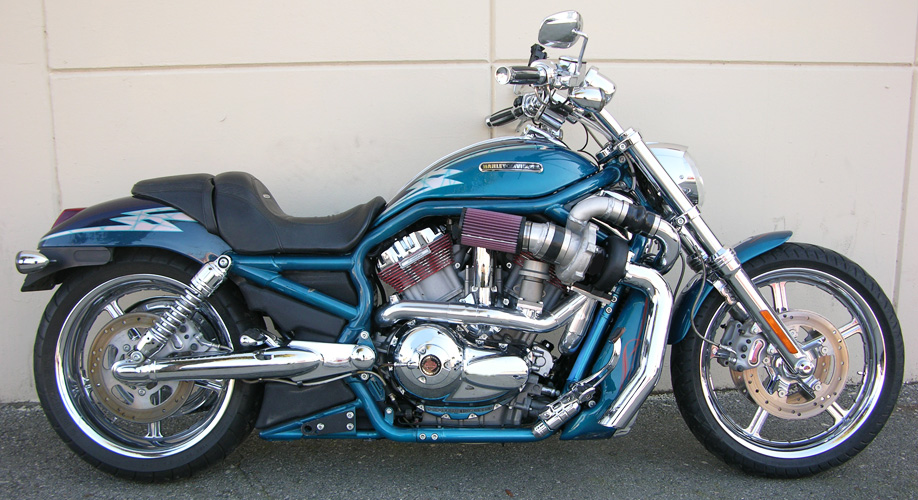
Right side
view RB Racing V-Rod Turbo. BoostMaster Billet wastegate (rider
adjustable). 2 1/2" Chromed exhaust. 360 hp turbocharger.
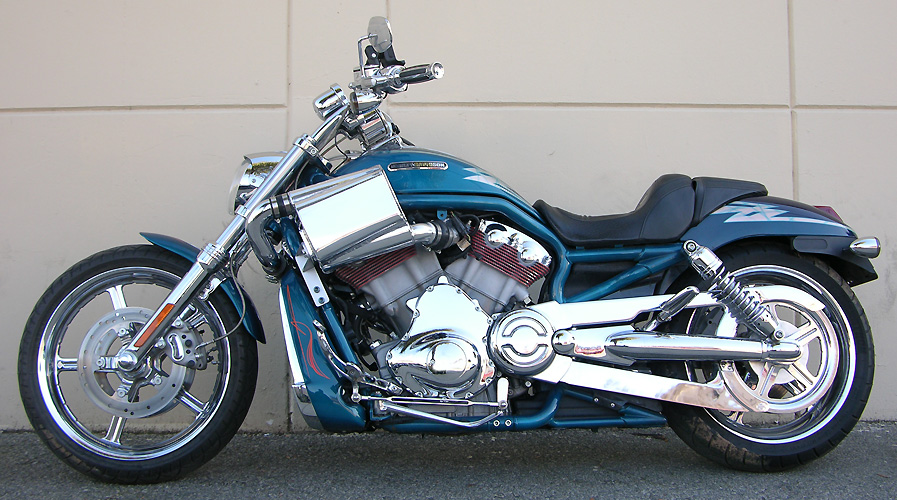
We sort of
left V-Rods alone as we are always busy and new projects take an awful
lot of time and resources if you want to do things right. More than a
decade after Willie G and Porsche came up with a 60 degree street bike
and after the failed water buffalo road race VR1000 we decided to turbo
the
V-Rods. Time, money, resources. Left side view showing ram air 360 hp
intercooler. Horn and clock switch get relocated. No need to cut any
coolant lines.
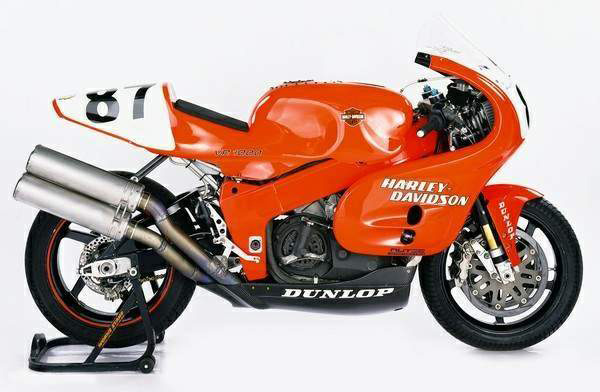
The VR1000 came to the show heavier than the competition and with less power. This is not a formula for success. The V-Rods are sort of the same way. They are high RPM 4 valve engines that are pretty quick but not real fast...and they are a bitch to work on or hop-up... Harley's answer to the metric crowd. There is no end to the hop-up route on the big twins, but nowhere to go on the V-Rods.

Harley's answer to the slow and heavy formula was to crank out a
factory drag bike, the V-Rod Destroyer, that had about 165 hp and ran 9
second quarter miles. We'd go to the races working on our friend Carl
Pelletier's Top Fuel Harley and gaggles of these would show up..mostly
Dealer owned. A few times some V-Rod Turbos by two other manufacturers
would show up and run in the 11's. That was pretty embarrassing. There
really isn't any point in showing up with a turbo if you can't outrun a
normally aspirated V-Rod Destroyer. A 165 hp turbo that only makes
boost high in the rpm range with a small turbo has no chance against
the Destroyer. Tuck your tail between your legs and go hide.
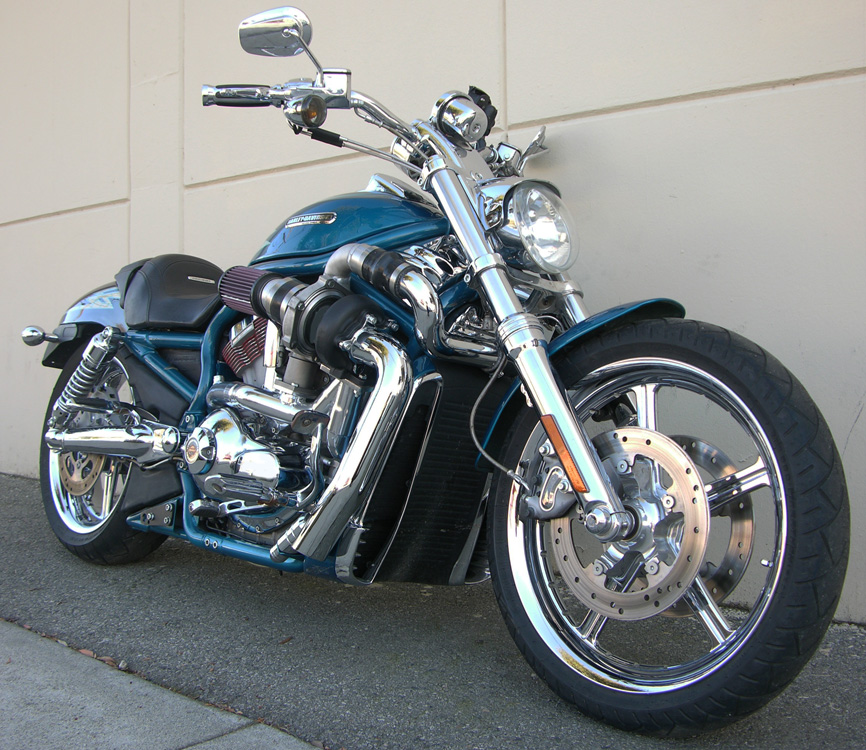
RB Racing V-Rod Turbo: RB Racing uses 360 hp turbos, not 160 hp turbos. Our turbos move a lot of air at low pressure ratios and are rider adjustable. You want to be able to cruise at high speed, not be under boost, but go into boost instantly when you roll on the throttle. You can adjust the boost from the handlebars while you are driving...5 to 25 psi. No muffler goes inside your legs.
V-Rods are
sort of annoying at speed as a fast cruise has the motor spinning along
at 5000 rpm like a Japanese sport bike. We recommend regearing the bike
with a chain drive and gearing it taller and use the turbo's torque to
keep the cruising rpms down and the mileage up.
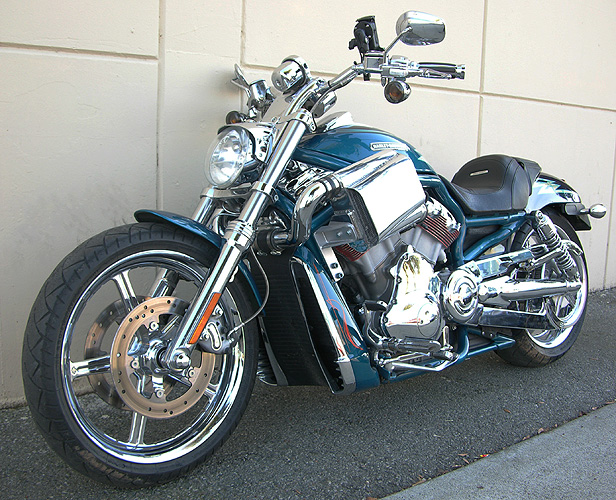
These are
strange bikes. The bike is a narrow V-Twin but the bars and the pegs
stick way out in the wind. We put on 360 hp worth of intercooler on the V-Rod but
had to use ram air to keep the bike narrow. Dating back to 1985 with
our work on BMW K100's we knew the intercooler could not block the
radiator. If you do not drop the charge temperatures you simply cannot
run higher boost levels.
Fixtures, R&D
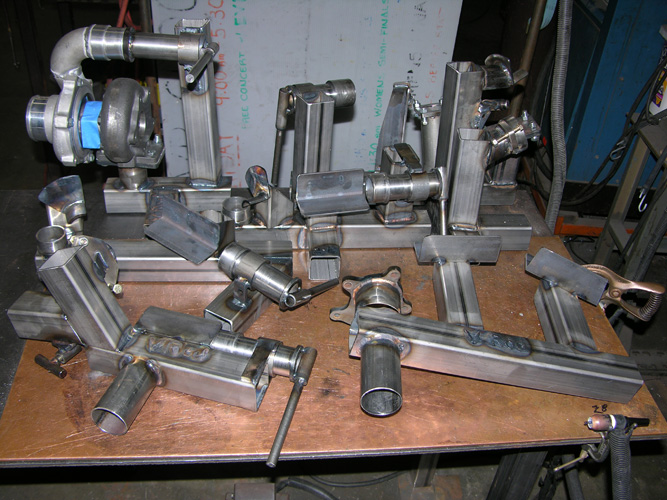
After 35 years of turbocharging
motorcycles we have come to some conclusions:
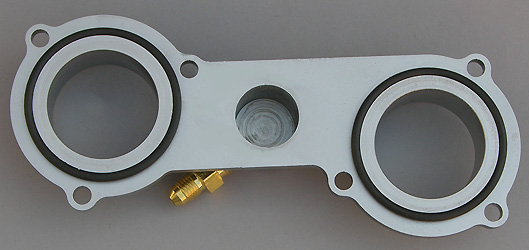
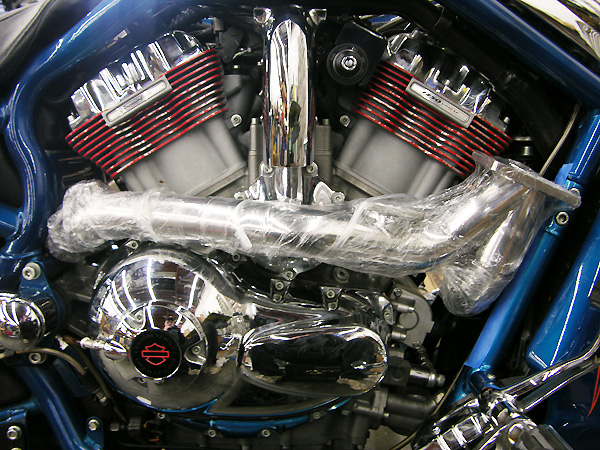

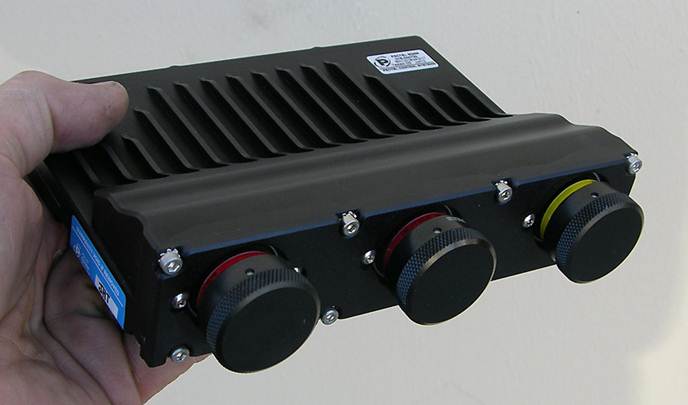
First Fuel Injected Harleys in the 9's, 8's and 7's..RSR EFI
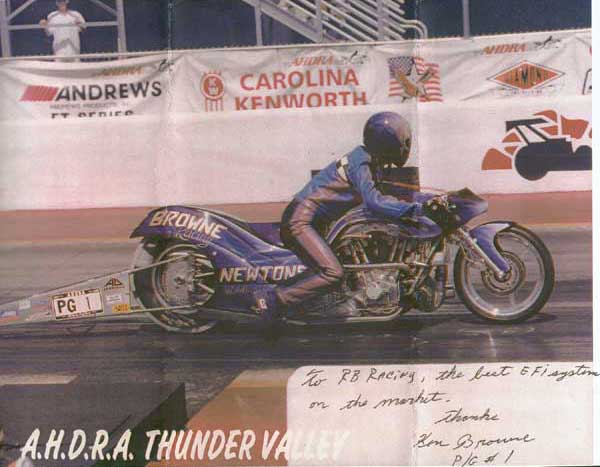
We've been at this for awhile from our early 80's 150hp Shovelheads up through our new 360 hp Turbo Kits . We put the first fuel injected Harleys into the 9's, 8's and 7's at the drag strip. The only fuel injected intercooled Harleys that hold national drag racing championships and Bonneville records come from one place..RB Racing.
Whereas people love to talk about about turbos and, if they have touched one once in their life they become experts, we have been at this long enough to know what should be done and what the difficulties are. It's always amusing the see the poor engineering that comes and goes in this market. It's not about plumbing and band-aids.
RB Racing Turbos Since 1979
From our first draw thru carbureted Harley designs in 1979 (See photo below) to the first blow thru carburetted designs in 1985 and on to the first fuel injected models in 1989 there has been a constant progression to improve and advance the art. We were pumping out 150 Hp Shovelheads in the first successful "draw-through" carb design in the late 70's and early 80's. See photo below. Some backyard garage types are still trying to market "draw through" carbureted systems but they aren't nearly as sophisticated as what we did over 20 years ago.
Some people claim they have been doing turbos since 1977 and that they were the first to do all sorts of things. We sort of remember them buying parts from American Turbo Pak, spending lots of money with Orient Express and bugging us about how to do remote oil systems. American Turbo Pak went out of business in the 1980's and one of it's founders, Bill Hahn Sr., a real turbo pioneer, passed away in 2009. It sort of makes you wonder why someone would use the initials ATP some 20 years later. Still clinging on coat tails.
1980 RB Racing Turbo Shovelheads.... Click on photos to enlarge
Blow Thru Carb Designs SUCK!
Don't confuse or even try to compare RB Racing Turbos with other "Harley Turbos" such as Aerochargers which are a simple copy of our "blow thru flat slide carb" design of 1985 to 1989 that reached a high point with Joe Walker's famous show-winning "Jap-Zapper" Turbo/Nitrous 1989 Springer Softail that won 1st place at the 50th Sturgis Rally (See Photo below). Blowing through a carb not designed for pressurization is an invitation for disaster due sealing problems, backfires, lack of float capacity and possible overflow problems not to mention no one ever tells you they can't possibly get it "correct" for all the different motors out there. We know, we've done it, we've been there and we dropped the deal after four years of seeing the good and the bad side of blow thru designs.
Joe Walker's famous "Jap Zapper" our last "blow thru" design (1985-1989)
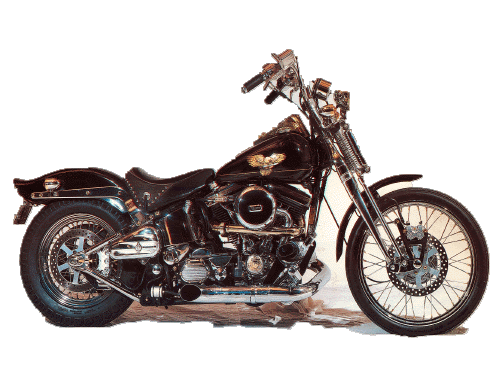
A long long time ago we made blow through carb turbos. We tucked a small IHI turbo between the frame and the engine. Blow through carburetion is a bitch. We had to make all sorts of special parts to make it work. Joe Walker won innumerable "shows" with this bike. Later on we fuel injected the bike and Joe added twin nitrous bottles. We simply do not understand the show mentality.
Aerochargers
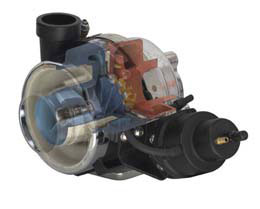
Typical E-Mail..."I am a EX-Areocharger turbo freak. I love turbos. But after tearing the variable vanes out of 3 Aerochargers, I decided that they are worthless if they can't hold up. The last one only lasted about 2500 miles. Too bad someone doesn't make a self lubrication turbo without them variable vanes. So for the mean time I am going back to natural aspirated. But I know I am going to hate only having only 90-100 HP and not having my close to 200 ft. lbs of torque. So I am looking at the conventional turbos. I wish I had found RB Racing first!."
Other Turbo Companies...110 Horsepower...Can You Handle It?
These tubing vendors and pseudo turbo people do not give you any form of sophisticated fuel control, do not offer rider boost control, use an integral cheap stamped steel wastegate, and ask you to drill and tap a regulator in your fuel tank running a 1/8" plastic tube to it. No one tells you 110 horsepower coming from a hair dryer tucked next to your leg makes less power and costs more than your standard big bore hop up. Hell you can drop in a bone stock 124 S&S engine and get 130 horsepower and not have to deal with poor engineering. Get an integrated 110 kit from Harley and 110 hp...it's cheaper....or a new SE 120R engine and get 135 hp.
If you ask other turbo vendors the usual question that prospective buyers ask.."how much horsepower will my motor take", as if it was some sort of guarantee, they usually come up with an arbitrary figure of "maybe 135 horsepower". Well bippy, you can buy a normally aspirated engine that makes that much horsepower without a turbo for less money and skip their poor engineering. We aren't the least bit interested in limits.
Our answer to the usual question about horsepower is " We give you a 360 hp turbo that moves a lot of air at low pressure ratios and you can dial it up to deal with anything you encounter simply by turning up the boost while riding". Larger turbos move far more air at lower pressure ratios. RB Racing does not place limits on what you need horsepower-wise. We have the technology.
SE 120R Engine...135 hp No Turbo
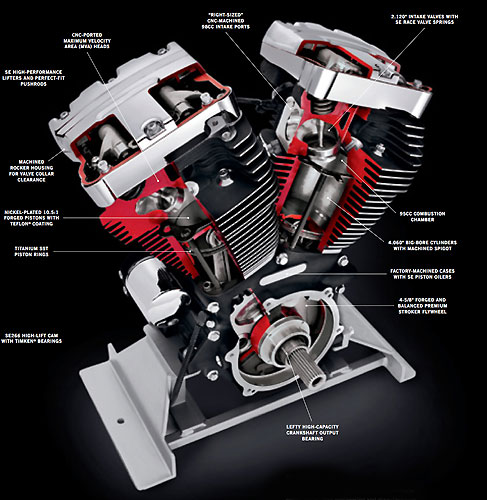
New 120R Engine for Baggers and a new AHDRA racing class...another way to get your money now that V-Rod Destroyers are old news. Think of all the early adopters who went 95/103/110 and now they can go 120". Stimulus money! Of course it's about 100 to 200 hp shy of one of our turbos. Add an intercooled RB Racing Turbo and 200 hp is dead easy.
As all the mythical lemmings head off the cliff we might remind them that a S&S SA B2 126" engine is rated at 154 hp and John O'Keefe at Branch O'Keefe has been working SA B2 heads for big inch Sportsters, S&S 124" motors and getting 166 to 200 hp depending on compression. Bob Bennett has set a bunch of Bonneville records with Branch O'Keefe S&S SA B2 heads modified by John O'Keefe. Of course you could get one of our turbos but the extra 100 to 200 hp might be too much power for you.
Stick on a set of S&S SA B2 heads on the S&S 124 and get 150 horsepower. Put on one of our turbos and get 250 to 360 horsepower...or 200 horsepower with 12 pounds of boost.
Why in the hell would you put on a turbo to get only 110 horsepower? These people will tell you " Extensive engine damage may result" if you go above 8 psi and 110 horsepower. Like we said...no fuel control, no engineering. Hell, we made more than 112 hp just using a standard 96" S&S engine more than 15 years ago with just a LSR 2-1 exhaust and mild engine work.
No Turbo...Think about it

Hers's a perfect Video example of one of our customers with our LSR 2-1 Pro Stock pipe and no turbo. If you think one of the "in your leg turbo" vendors can outrun this bike think again. If you see this bike pull over and park. No turbo and it's FAST.
Bonneville Testing

Here's the 139 Inch Orca Bullett with it's large diameter stainless steel merge collector exhaust system and large air to air intercooler. Pretty much state of the art insofar as pushrod Dinosaurs go. Designed for the long course at Bonneville. 600 HP Turbo. 500 hp @30 psi on this 139" engine. In testing we have run 212 mph @ 4700 rpm with 9 psi of boost. Next step 230 mph plus. It only runs a couple of minutes at a time...not much time to insure it is safe. It has passed all SCTA-BNI and AMA/FIM inspections and Bryan Stock, filling in for Mike Geokan, has got all three licenses 150, 175 and 200 mph and is cleared for long course at Bonneville.
With Brother Speed's
Bryan Stock in the seat it currently holds a 200 mph record at
Bonneville in "low boost" testing. We held Bryan to 4800 rpm to let him
get a 200 mph SCTA-BNI record. It has run 214 mph with just 9 psi of
boost. Next up is more advanced electronics and 230-250 mph.
Mike Geokan's RB Racing Turbocharger uses a separate oil system that has a stainless steel oil tank and an electric feed pump that maintains a constant 30 psi to the ball bearing turbocharger. The engine runs 50 weight Brad Penn (ne Kendall) "Green Stuff" oil and the turbo runs Brad Penn 20-50W.
Black Strips Lasting Longer Than 6 Miles
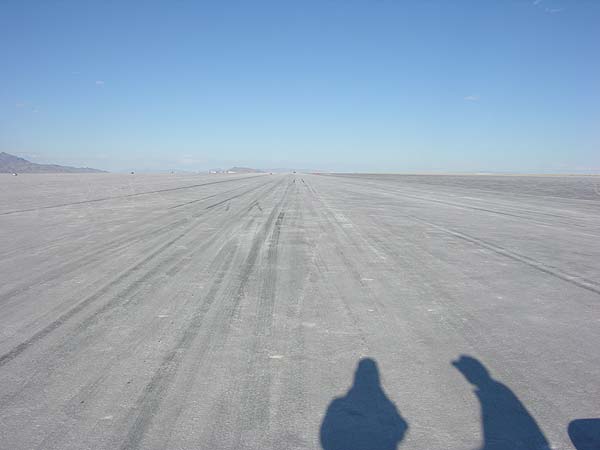
If you experience black strips lasting longer than six miles seek immediate mechanical attention and replace your RB Racing components with stock ones. Continued use can cause loss of licenses, premature tire wear, and infuriate your competition. Bonneville Salt Flats...where we prove our products...and have done so for more than 30 years.
Mike Geokan's Bonneville Harley...30 years of RB Racing Turbos
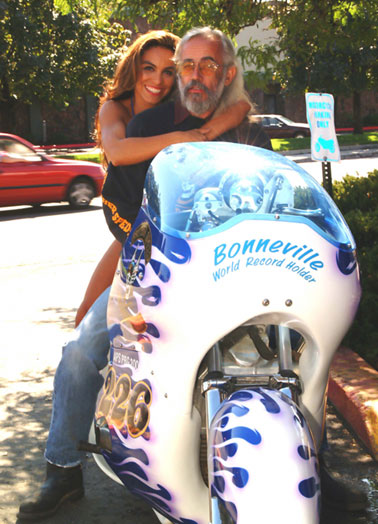
Can you take your 250 hp Harley race bike and cruise around to thank the people who have helped you set records? It takes a lot of people to build a bike from scratch and to support a race effort.... Painters, welders, fabricators, engine specialists, fellow club members, and even professional dancers like Salina. You never do it alone and if you don't take the time to thank those who helped out it's going to be a cold lonely night with you and your time slip to keep you warm.
Salina moved on long long ago...you can't feature dance forever.
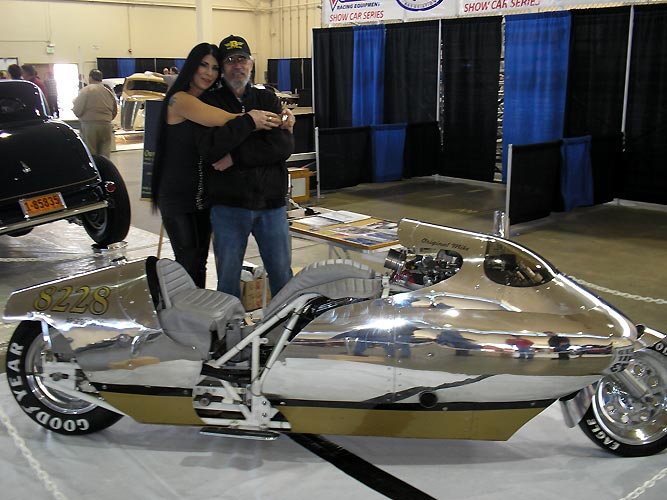
Mike was running 199 mph in Bonneville Slush with 22 lbs of boost and 275 horsepower way back in the 1990's. These days Mike's attention is devoted to his 139" ORCA powered Bullett. His friend of 40 years Bryan Stock has taken over the riding chores. Mike still gets the pretty women...guess it wasn't the bike after all.
In 2017 we bid farewell to the Bullett
Project. Mike was finally well enough to open up his ugly take on the
world. One's true nature always comes to the front sooner or later.
What the hell..It was fun with Bryan and the crew and we got Bryan a
200mph record. Mike can now pout, scowl, and keep getting people to pay
for his project while he putters around watching TV, eating out twice a
day, and talking about the distant past through rose-colored glasses.
Mike Geokan's world record holding RB Racing Turbocharged Harley Davidson is featured in a new video.
Wastegate: $10,000.00 down and many more dollars to go
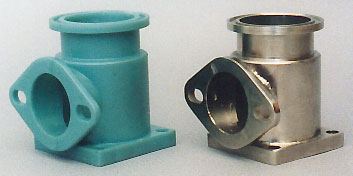
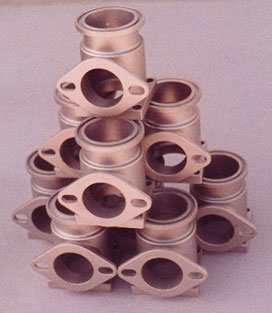
Pictured above are some of our investment cast stainless steel Boost Master wastegate bases. The first one costs $10,000.00 but they get cheaper after that. The wax pattern is to the left. We machined a prototype, picture on the right and then went to investment castings. All CNC machined billet parts.
It's a complete system
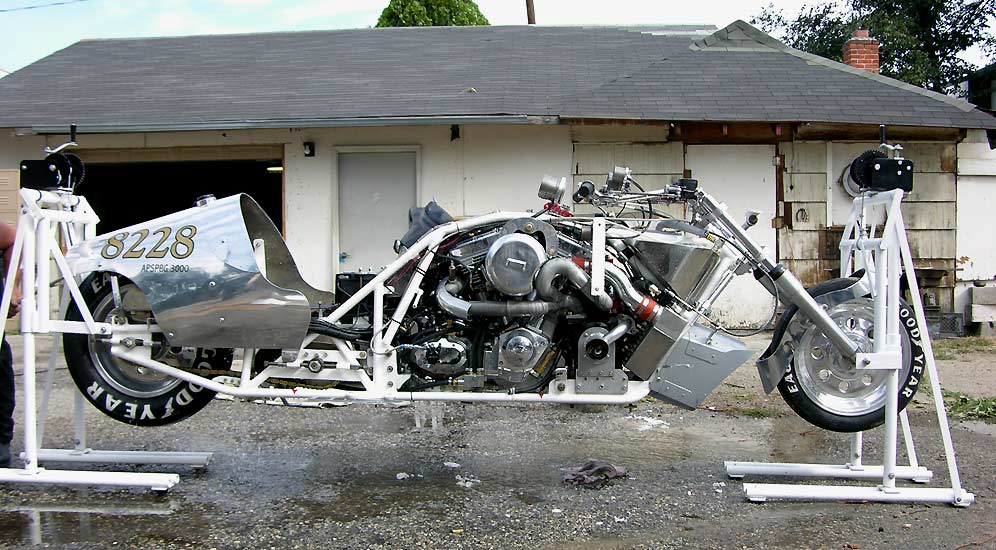
A complete systems approach is why our RB Racing turbo kits produce so much power at low boost levels and why they work so well in day to day operation while giving excellent fuel mileage and driveability. More often than not people come to us after spending some astronomical sum of money on their engines only to be disappointed in the result. When we tell them they have to start over with different pistons, cams, gaskets etc they reply that their motor will be just fine turbocharged at 10.5:1 compression ratio and 15 pounds of boost. Since everyone is an expert we no longer try to advise them differently if they so object...Everyone has to learn sooner or later. We do recommend 8.5:1 if anyone wants to listen...of course this all depends on cams but that is another story all together.
For those who are in the planning stages we can offer complete 113/126/132/139" Turbo ORCA motors that have all the right stuff in them. When you purchase an RB Racing turbo system we ask what your intended use is and structure our advice based on the latest information we have. Look at the early RB Racing turbos above and the pictures in this section to see how far we have come in nearly 30 years.
Harley Motors and Turbos
Can I put a Blackbird 250hp turbo on my stock 80" or 88" TC88?...hell yes! Will it make 250hp and be reliable?...Not if you run 15-25 psi of boost! What should I do if I leave my motor stock?...Well, if you run around 8-12 psi with our system you will outrun about any big inch mega motor you come up against...for less money.
Keep in mind we use only high output 360 hp turbochargers that move twice as much air at lower pressure ratios that other firms. We do not use small cheap turbos. You need to know how much airflow is required to make your horsepower at a given pressure ratio. Engine displacement figures into this equation. Check out our calculator on this.
1. Cams: Stock Harley motors don't have enough "cam" for turbos as they are basically short duration next to nothing in the overlap or lift department. The stock cams will boost if you look at them but they just don't breathe well enough. Your horsepower and breathing capacity will be restrained. Remember, we are going to run at least twice as much air through your motor even at low boost. Best use some drop-in cam...just don't tell anyone it's for a turbo! 135hp should do the job in most cases. If the need arises up it to 175hp. We use specialized turbo cams in our higher output ORCA motors.
2. Cranks: No one tells you the Twin Cam engines are dumbed down Evos and will twist their pressed together cranks when you abuse them stock. Guess what happens when you turbo them? If you buy Harley's 110 Kit they want you to bore your cases and put in a Timken bearing on the drive side and weld your crankshaft. When the crankshaft twists it takes out your gerotor oil pump and lunches your motor. Twin cam engines need Timken upgrades and welded crankshafts. No one tells you this.
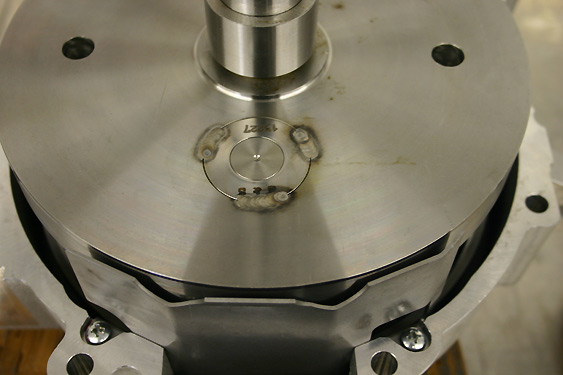
Evos require special setup with additional clearances. For extreme racing we use 1.500" crankpins with press-in and welded components with stronger rods and .927" heavy wall pins. We also weld crank nuts and suggest welded in pinion shafts. Pictured above is a 126" S&S SA B2 engine crankshaft being prepared for the Road Toad.
3. Clutches: Most clutches are marginal after about 115hp. All the Kevlar wazoo plates won't save your ass and in most cases are worse than oem clutch plates. Increased frictional area and pressure are the answer in the form of Screaming Eagle, Rivera Pro Clutches or Bandit clutches. Plate area, spring pressure and coefficient of friction rule the day. All the common wisdom about clutches goes out the window with turbos. Simply stated, you can alter the frictional area with a 9 plate unit, or you can go for wider frictions like a Rivera Pro clutch but, in the end, it will be the pressure acting on these that rules the day.

Pictured above is a Magura hydraulic clutch for certain models of the Big Twins, a drop in replacement for cable activated clutches. It lessens the lever effort by 30-40%. Going hydraulic is about the only way to deal with Bandit or Screaming Eagle Race clutches that have heavy (adjustable) coil spring presures. Later model CVO models come with hydraulic clutches.
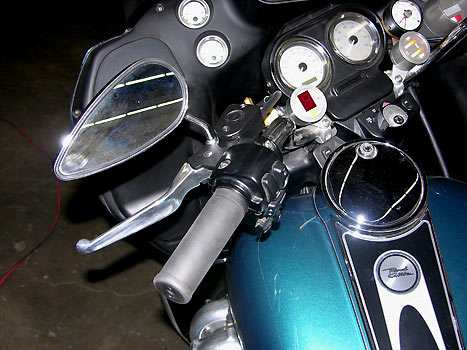
Lockup clutches from Bandit, AIM, Rivera and others are suggested for even higher output but they add complexity to the mix and may require modified clutch derby covers to clear the additional height. For you killers out there you will be on your own and have to go directly to hydraulic clutches, sintered iron dry clutches, outboard support bearings and centrifugal lock-ups. That's what we do on the 400+ hp Bonneville Bullett. Pictured above is a Magura hydraulic clutch on our Road Toad. With stronger spring pressures it's the way to go...or get an oem Harley hydraulic clutch.
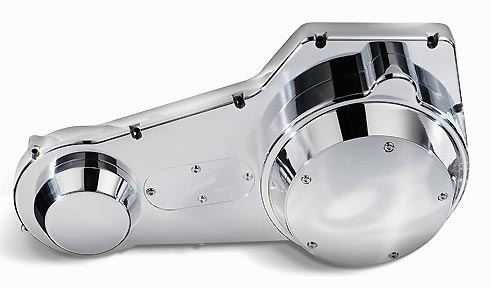
In the case of the Bonneville Bullett we even went to Barnett billet primary cover that centers the clutch basket on the clutch inspection plate in order to clear the Bandit lock-up mechanism.
4. Rods: OEM connecting rods are ok but not for really high horsepower. If you are a racer you already know this. Go directly to S&S Supreme rods for most applications if you are planning to run high boost. S&S Supreme rods shown below. It's not a bad idea to get rods with larger, thicker, piston pins like .927" and the pistons to match.
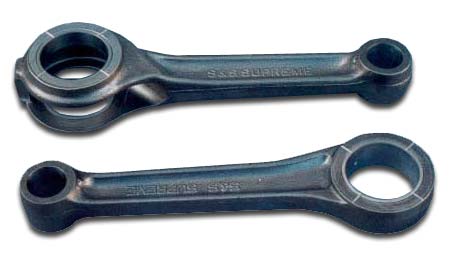
Shaker Carrillo 8" Nitro Evo Rods...139" ORCA
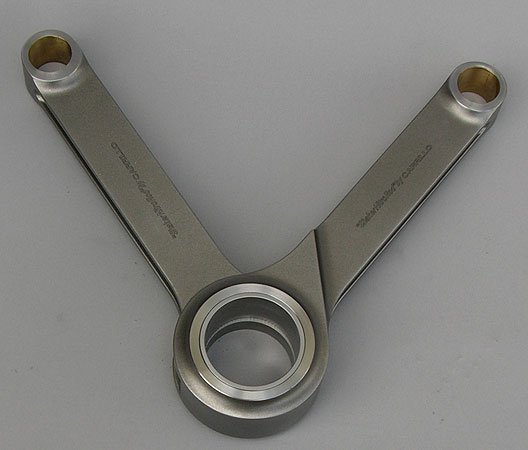
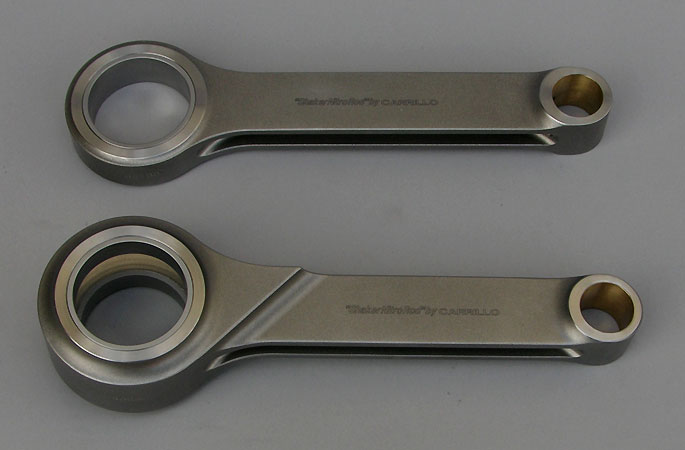
On our 139" ORCA Turbo motors we use special Shaker Nitro Carrillo Rods or McClure Nitro rods.. Big strength equals big money. We had these custom made for our engines after it became next to impossible to get the McClure rods we used in earlier engines. 1.5" crankpins and .927 Nitro piston pins.
5. Pistons: OEM cast pistons are weak. No high boost or racing turbo motor should be put together without forged low compression (8.0:1) pistons. You can run the stock pistons but not for extreme output.

OEM pistons run tighter clearances and have excellent rings but being pressure cast they can crack whereas a forged piston will deform. RB Racing carries specialized turbo pistons....the ones pictured above are for our 113" ORCA motors.
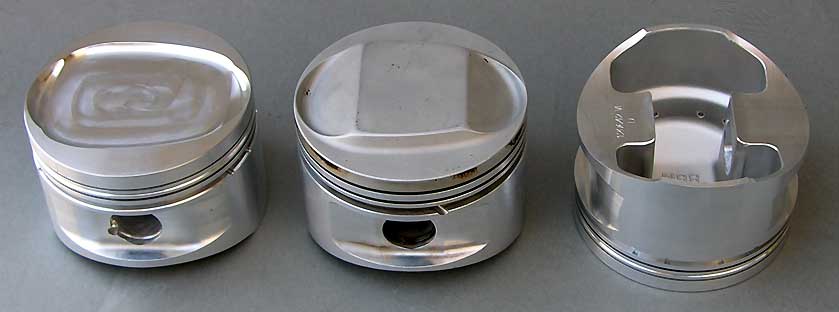
The typical path to power is compression, represented by the center piston, which in this case is 10.5:1 static. You reach a limit quickly which, depending on other modifications, leaves you stuck in the 1 hp per cubic inch, 1.125 or, if you really push things, 1.25 horsepower per cubic inch. An 80" engine pushing 100 hp (1.25 hp per c.i.) is really edgy. Switch to an intercooled, RSR Closed Loop Fuel Injected RB Racing Turbo and add water injection and you can go right to 200 hp. The forged low compression turbo pistons replace the high dome, high compression normally aspirated pistons.
If you think you can get 3 hp per c.i. with the center high compression (10.5:1) piston we wish you luck. With a turbo you just run around with a stock or low compression piston, and have an easy-starting engine that gets great fuel economy and you dial up whatever power you need. You have to do it right, however, which is why our kits often involve forged turbo pistons, closed loop RSR Fuel Injection, water injection and are all standard with large intercoolers.

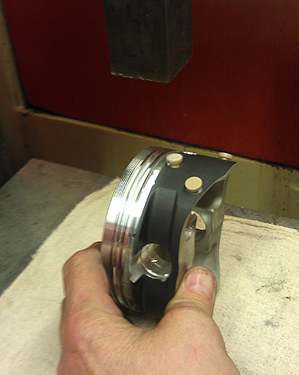
When you get really serious you do like we do and order up $3,000.00 worth of CP pistons made to our specifications then get the domes ceramic barrier coated and the shirts coated with and anti-friction graphite...Then custom machine them for PEEK shirt buttons. Thicker domes, better rings, heavy wall piston pins. Whatever it takes.
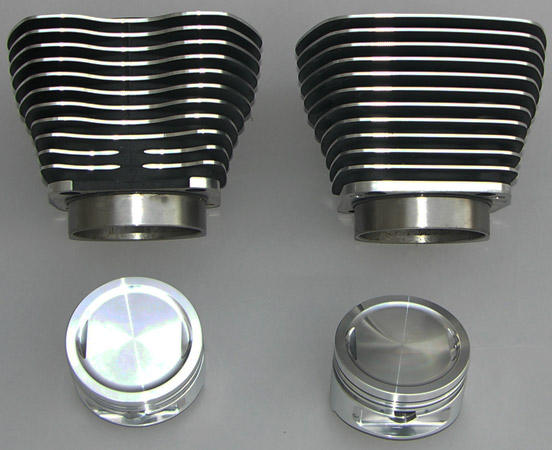
Here are a set of turbo pistons we are preparing for a customer with a 95" engine. Since the customer is out of the country we purchased a set of oem cylinders and made up the turbo pistons. Next step is for the cylinders to be bored and honed for the pistons. We will then get the pistons coated on both the skirts and the crowns for the RB Racing Intercooled turbo. Not cheap, but cheaper then sending things back and forth over the Pacific Ocean, or having it done locally on the customers end, where there may or may not be the expertise.
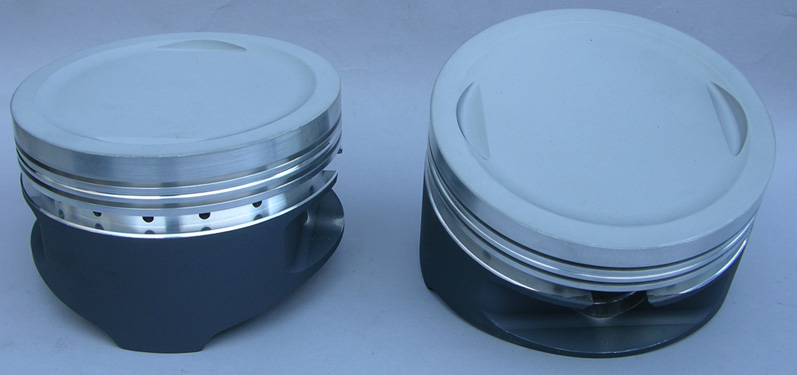
We offer
this service for the various 95/103/110/113/120 piston bore and stroke
combinations. Forged heavy duty pistons, special turbo rings and heavy
wall piston pins, specialized head barrier and friction reducing
coatings and proper bore clearances done professionally. Pictured above
are 95" Turbo pistons we prepared for a client. Note the strong
piston crown and top ring position.
6. Cylinder Sealing: Another weak point are the cases and cylinder heads. If you push past 200hp the stock cases won't be too happy. Sooner or later something will let go. Better off with S&S, Delkron or other race proven items. Below 200 hp and without banging speed shifts at 7000 rpm the stock cases are reasonably good items. The cylinder heads have excellent valves, guides and seals, but once again get too greedy and sooner or later you will probably find a crack around a spark plug thread. Keep the power reasonable and things will be fine. Use OEM Harley torque specs on your cylinder head "nuts" and check them periodically or you will pop a head gasket.
Cylinder Top End Sealing
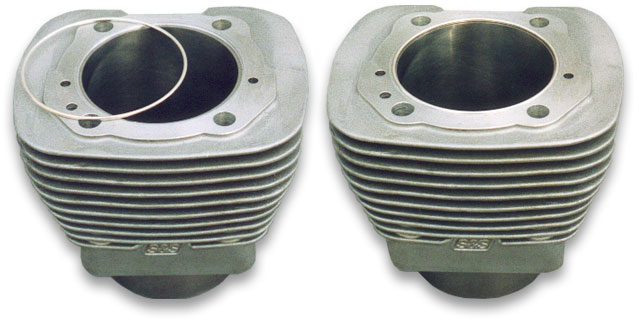
Copper head gaskets are a waste of time as they are certain to weep oil, even if a stainless wire is used as an "o-ring". Our ORCA motors use special seal rings and no gaskets, either base or cylinder head. Better heat transfer and no leaks. Use stock gaskets and torque values if you keep the hp down to reasonable levels. Don't boost the engine unless it is at normal operating temperature. We also run Champion Racing Spark plugs.
7. Porting of Cylinder Heads: Heads should be ported by someone who has experience with Turbos as they don't use the same flow ratios between inlet and exhaust. John O'Keefe at Branch O'Keefe does all our turbo porting work. When you get really serious you need to replace softer stainless steel exhaust valves with Inconel or similar extreme temperature rated valves like those made by Ferrea.
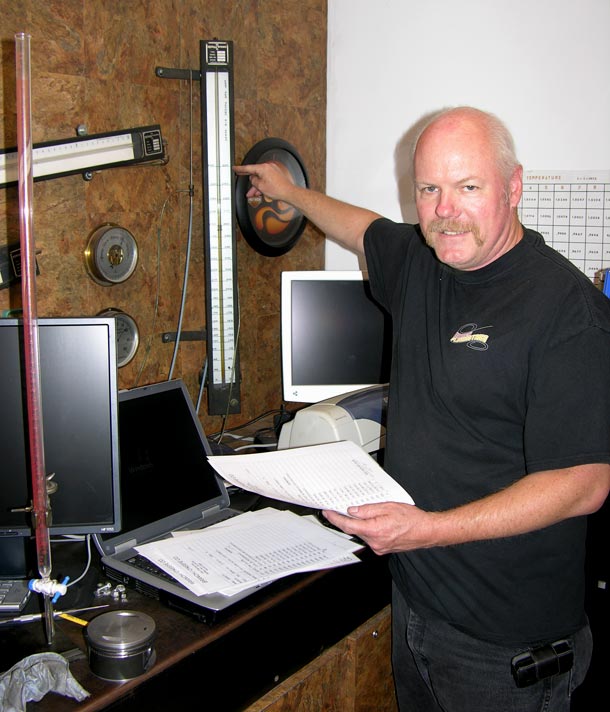
John O'Keefe does all our big valve S&S SA B2 cylinder head porting for turbos. If you want your heads ported for Turbocharger applications he is the "go-to" guy. Here is is pointing to the extreme flow number he got with our S&S SA B2 Bonneville Bullett cylinder heads.
Before Branch O'Keefe Turbo Porting
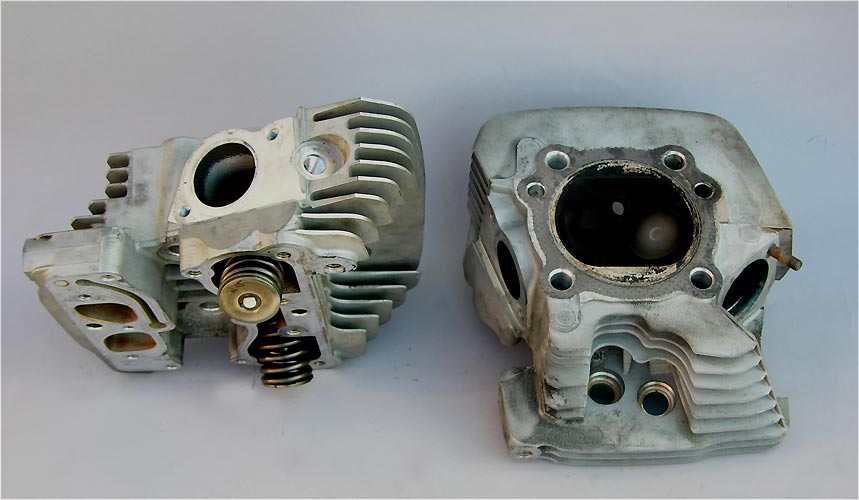
This set of Twin Cam 88 Heads had about 40,000 miles on them. They had excellent sealing on the valve seats but the guides were weeping a bit of oil. John said they were in good shape considering the mileage. The inlet ports had a bit of carbon but were very clean. We'll be showing you John's work to prep these for turbocharger use. He'll drop the cc's in the chambers just a small amount because the bike is getting turbo cams with more duration. John has special guide seals and valves that stand up to turbo pressures and temperatures. He'll open up the ports to let the turbo breathe with the new turbo cams. He's the go-to guy for serious racing like on our S&S SA B2 Bonneville Bullett heads pictured a bit below.
After Branch O'Keefe Turbo Porting
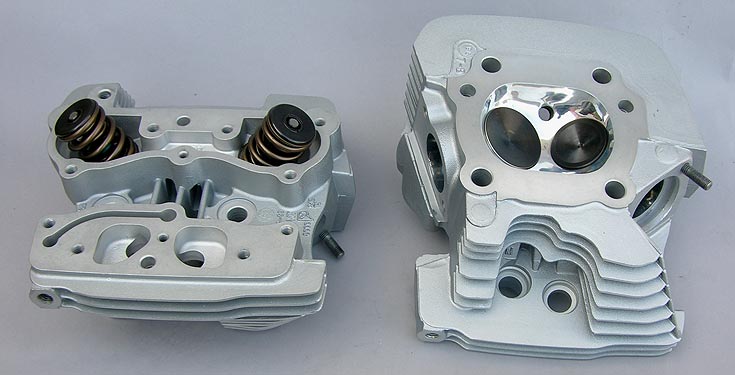
This gives you a pretty good idea why you should spend about $850.00 if you are going to turbocharge your Twin Cam. Just look at the before and after pictures. If your Harley has some miles on it you should get the heads prepared for the turbo...(1) Better and bigger valves; (2) Ported and flowed inlet and exhaust tracts; (3) High lift valve springs for the turbo cams and new Teflon Guide Seals; (4) Multi-angle valve job with turbo profile seats; (5) All carbon deposits, sharp edges and potential cylinder head / gasket deformation issues resolved; (5) Chambers matched and cc'ed to correct volume for the camshafts and pistons (dynamic compression ratio).
Besides, they look great and you know you love your scooter more than anything. Guess who gets the attention and the money. Anyone who says you don't need to port heads on turbos is dead wrong. Airflow, thermal stress, oil control and head sealing are all issues a Branch O'Keefe Turbo Porting job addresses. To paraphrase an old adage..."It's the airflow, stupid!".
Branch
Turbo Heads: 10,000 miles later...Inlet Ports Clean
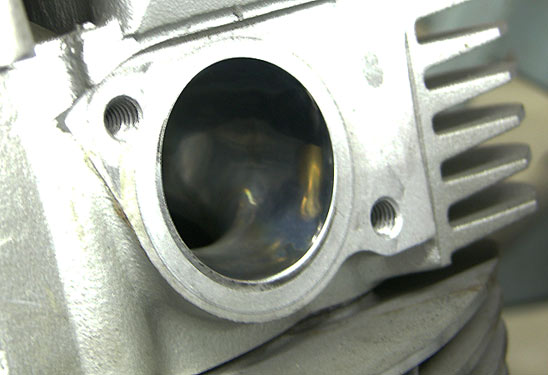
After 10,000
miles of testing on our Twin Cam 88 we removed the engine to put in a 126" ORCA motor.
The Branch inlet ports were perfectly clean. No reversion and perfect
valve sealing. Definitely the people to do your turbo porting.
Branch O'Keefe S&S SA B2 Head Bonneville Porting
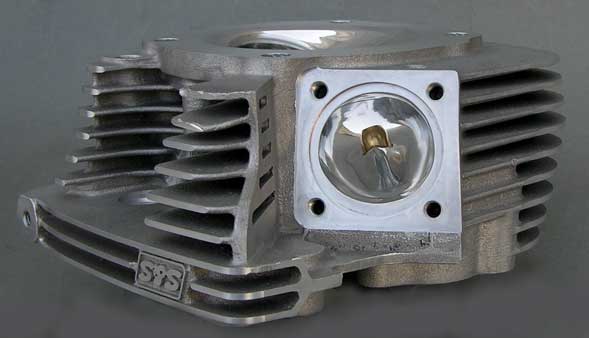
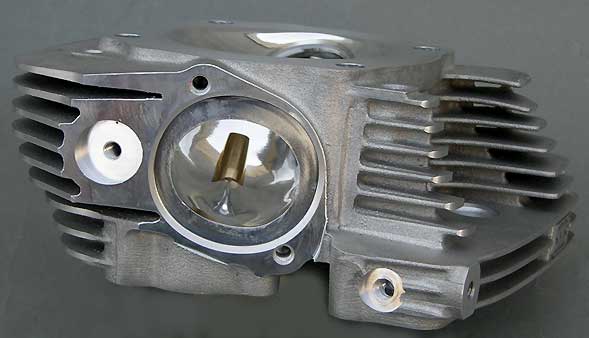
Whenever we do something serious like our 139" Bonneville ORCA motor we defer to the experts, especially when we are dealing with raw, unfinished ports the size of a dime. Branch O'Keefe is simply the best in the business and even Jerry Branch (retired) got involved in the decision making. Take a look at some ports that about 90 years cumulative experience came up with. All John O'Keefe and Jerry Branch asked was what we thought the exhaust ports should be like in terms of flow based on our 30 years of turbocharger experience. We all agreed on a number and this is what the result was. Ports for 400+ horsepower. 2.200" Inlets and 1.800 exhausts with special 2400 degree Ferrea valves. This is not a $850.00 porting job.
8. Fuel Pumps /
Regulators and Horsepower: Our
Delphi-based Turbo Kits use the OEM in tank fuel pump and regulator
assembly and there is no need to go into your gas tank and try to drill
and Loctite in some silly boost port into your OEM regulator. If you
are starting out with a stock bike and 150 hp will get you down the
road with low boost then you will be fine.
For our higher horsepower
applications either with our own RSR EFI or for Delphi-based systems we
use an externally mounted 600 hp fuel pump, fuel filter and high-bypass
billet fuel pressure regulator. For high boost and higher horsepower
applications the stock fuel pump and regulator assembly just won't cut
it. What is "high boost and high hp"?...Well, when you start heading
for 200 to 360 hp it's time to order the Pro Street System.
In the Pro Street systems the stock fuel pump and regulator are removed and the float level mechanism stays in the tank. We provide all the hardware and parts to covert the bike for up 360hp capability.
Branch
O'Keefe EVO Turbo Heads: STD, S&S and OEM
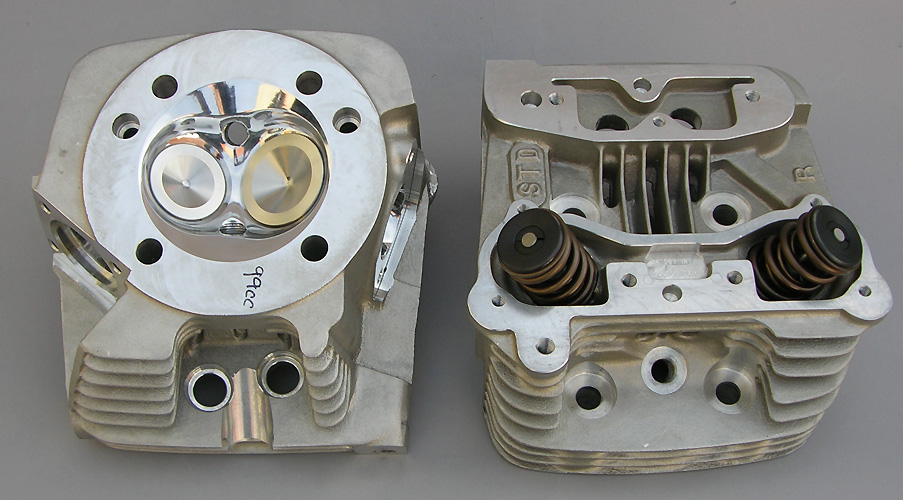
John O'Keefe at Branch O'Keefe also does our Evolution Turbo heads, whether starting out with S&S, STD, or OEM castings. STD went out of business but their heads were pretty strong and were set up for dual plugs. We use these STD heads on our 80" FXR Turbo. Stock OEM castings tend to crack at the spark plug hole whereas the S&S and STD are stronger. Dual plugging is a good idea even with the 3.5" bore. John set these up with 99cc chambers for our forged pistons with a 20cc dome to match the Branch chamber.
Exhaust and
inlet porting are critical on Turbochargers. If you are going to flow
3X the Stock horsepower you simply have to port your heads. Larger
valves and higher flow go with turbocharging. We've never had an
issue with Branch heads. On our Bonneville Bullett we've run 214 mph @
4800 rpm with 9 psi of boost. The Bullett is set up fro 535 hp @
30 psi of boost and geared for 294 mph. Only one outfit knows how to
deal with these flow issues. Branch
O'Keefe.
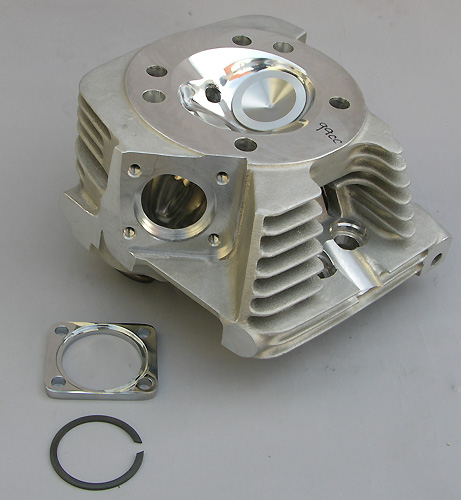
The STD four bolt pattern is simply a rectangle with dual OEM two bolt spacing. For our turbo FXR we use four bolt billet STD flanges that we machine up. Billet gaskets and four bolts gives a better seal just like on our S&S SA B2 heads. These days S&S SA B2 heads are available with the OEM two bolt pattern but we prefer the four bolt arrangement for turbos. S&S Supersport Heads are two bolt pattern.
All
performance turbos should be running Branch Turbo heads. The
programming changes radically between ported and unported heads as the
ported heads flow so much more air.
Twin Cam FL Chain Final Drive for High Horsepower

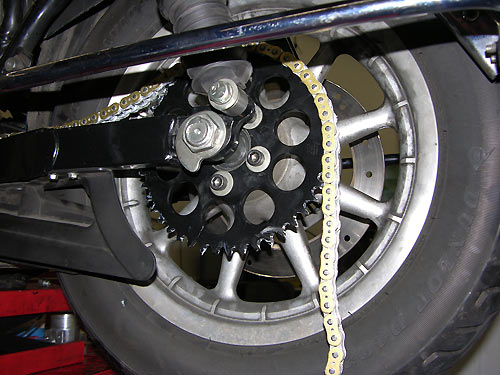
We converted the Road Toad to an EK 530ZZZ final drive chain, the same as we use on the Bonneville Bullett. A Baker Drivetrain 24 tooth transmission sprocket with a .200" offset and an anodized 45 tooth rear wheel sprocket lets us run the Road Toad up to a leisurely 180 mph without revving the 126 Orca Turbo motor too high. We geared it a tad taller so we can cruise at 80 mph well under 3000 rpm and get 50 mpg.
Chain / Belt Adjusters

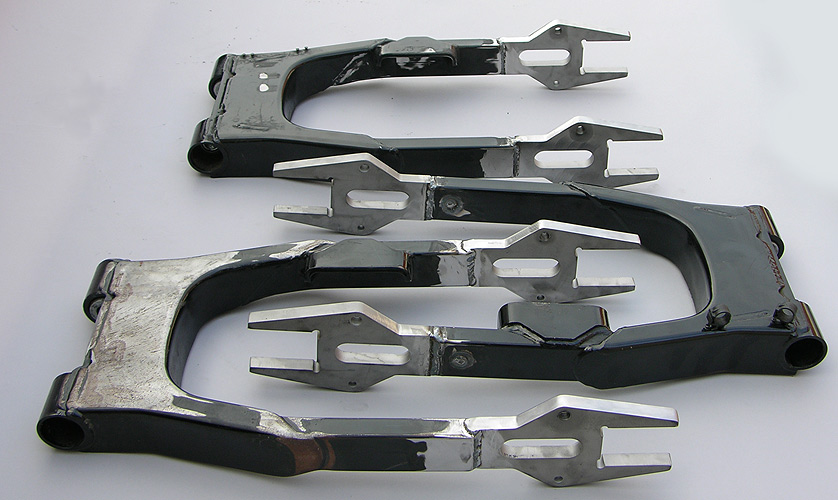
Three customer arms. Two for turbos and one for a Twin Cam S&S 124" with SA B2 heads that makes 150 hp. Go big or go home as they say.
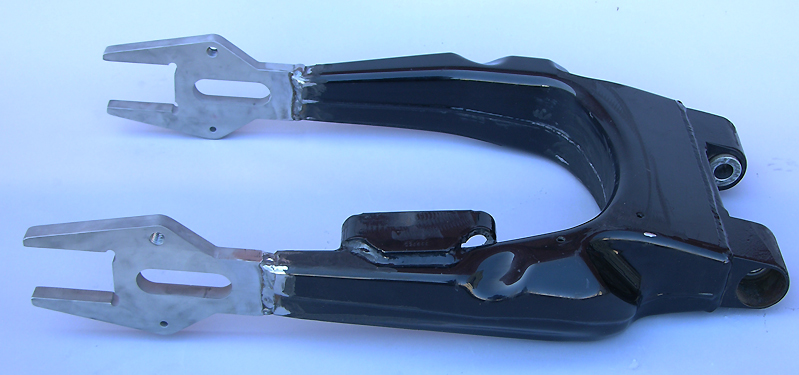
The 2009 and later
swingarms are completely different. We have
fixtures and offer a service to convert these
to chain drive. Aftermarket wheels can be used with direct sprockets or
the cush drive mechanism can be machined to accept a sprocket. Chromed adjusters below.


7 Second Old Pro Gas Design...Way More than Two Decades Ago
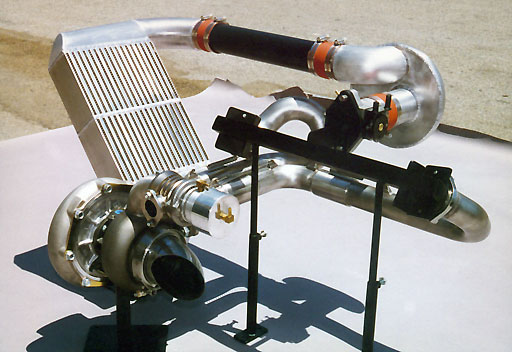
This Pro Gas 500+Hp system is custom built for race application and involves fabrication for intercooler mounts etc. at the builder / fabricator level. The Pro Gas system pictured below was built for National Modified Champion Wayne Pollack of Fuquay Varina, North Carolina. Wayne flew out to see us and agreed to build a bike around the system we would design instead of vice-versa. Wayne wanted to build a sophisticated Turbo bike but he made the serious mistake of ordering some cylinder heads from Nigel Patrick who did zero, zip, for a year after he took Wayne's money. The year delay caused Wayne to miss a complete season and his sponsors cut the purse strings and his "crew" dispersed to other projects. Wayne sold the parts to Ken Browne, who continued with the project, but cut up the parts and left off the 500hp intercooler. There went 1% in hp for every 11 degrees F the charge cooling would have provided. Those of you unfamiliar with how much air heats when you compress it...at 22 psi the discharge temperature can be 265 degrees F. You can't find any turbocharged race vehicle without a large charge cooler.
Ken still managed to run 7.55 @ 173mph (176mph best mph) in the quarter mile and 4.80 @ 147mph in the eighth mile, and built a new bike with a bigger tire!
Ken's new bike is (2002-2004-2005 etc.) was further away from "what should be" and didn't work well. More weight, poor turbo location etc. Ken is a nice guy, but bad ideas, no matter how nicely executed, simply won't work. We talked to Ken, hoping he would just execute our original design, but everyone wants to do "his own thing". There is always a price for this. Hey! It's not death..It's a hobby!. Hey, he's even building a third one. Ken had to quit riding after a not too successful neck operation.
Wayne Pollack went on to wrench and ride the beautiful Majestic Turbo bike, initially with twin turbos (didn't work well) and later on with one very large turbo similar to the one pictured. We sent Wayne the turbo specs and drawings for a new design so he could shit-can the two turbo deal that Kevin Draper and Don Vesco cooked up. Wayne got to deal with methanol and Hilborn injectors with nitrous added to the mix. Boom! Blow up an Overkill Engine.
Wayne was always straight with us, he's a hard-core racer and like Wayne, we think there's nothing much better than kicking ass and trying to be the best at what you do...Wayne went off to ride Ray Price's Top Fuel Harley and to stay in shape just ran a 242.587 mph World Record ( Sept 2003) on Rich Yancy's turbo Hayabusa at Maxton. In 2005 Wayne upped the Maxton record to 258mph on Rick Yancy's Hayabusa.
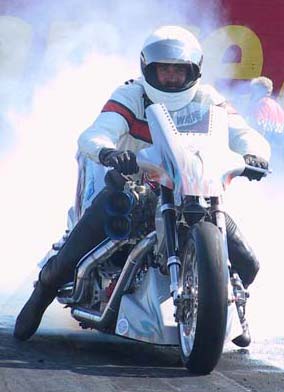
Here's Wayne on Ray Price's Top Fuel Harley (Oct 03). Ray got a bit banged up and Wayne was tapped for the ride. In August 2004 Wayne retired with back problems...no more spine crushing acceleration. Wayne went on to set a speed record of 258mph on a Hayabusa at Maxton in 2005.
We get a few calls each year about Pro Gas systems. We suggest you call us before you start building. Everyone wants to do their own thing but decisions can haunt you and they get expensive. If you're already far along we'll sell you some parts and keep our mouth shut in the advice department because it will already be too late.
Click on the below pictures for more details on these parts and people.
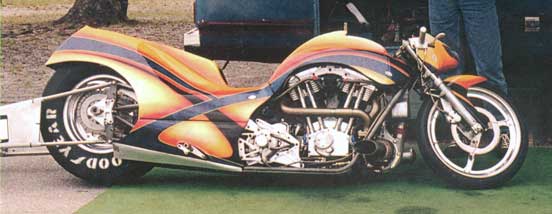
Ken Browne's original record setting 120 cubic inch 4 cam Pro Gas bike. RB Racing Pro Gas Turbo / RSR 400i Fuel Injection System. Best 1/4 mile E.T. 7.55; best mph 176. This gives you and idea of how much power is hiding in our street Blackbird and Pro Street systems.
Lindsay Ford
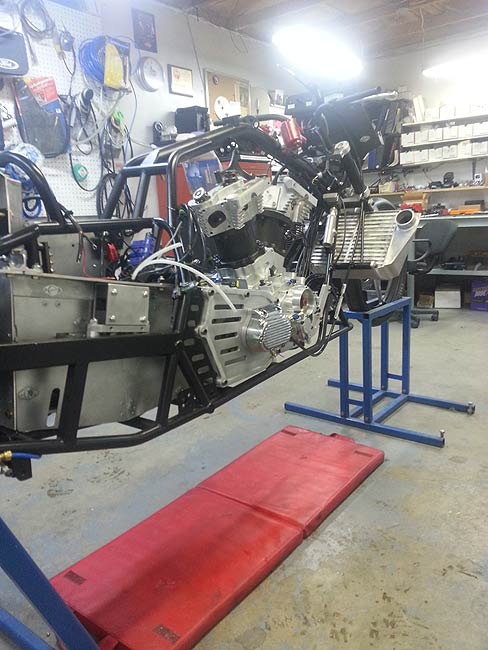
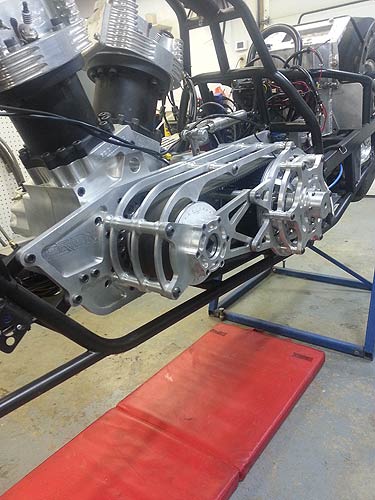
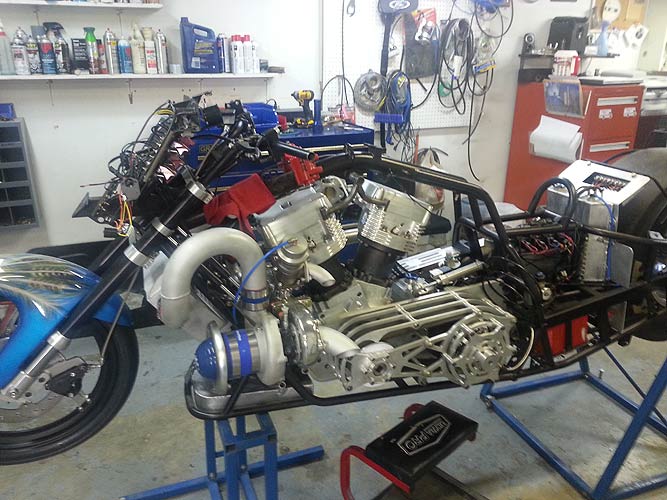

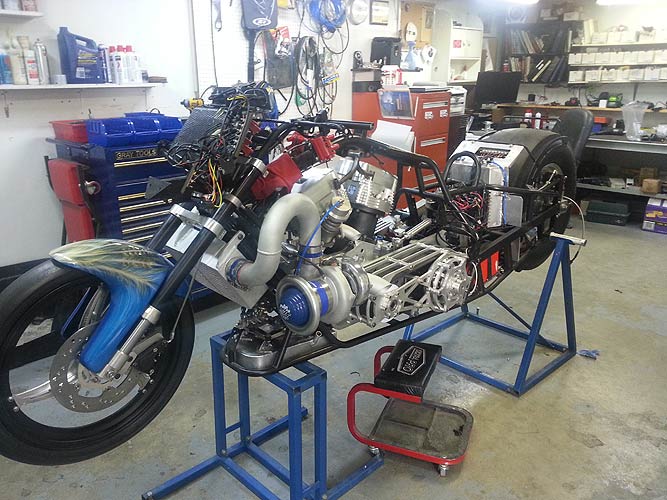
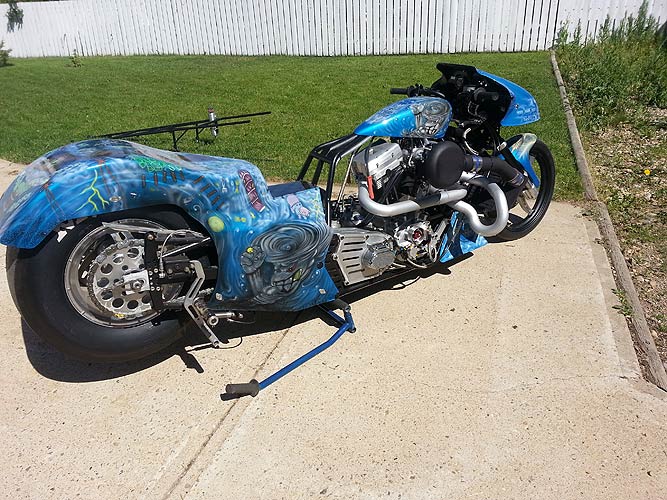

Derringer
Motor. RSR Fuel Injection. Fabrication by Lindsay Ford. There projects
take all your money, all your time, and years of work. Finally you
get to ride.
Designed For All Big Twins....

This is a Confederate with a 120 Cubic Inch Merch with one of our Pro Street Turbos bolted in place. We didn't run the bike, we just checked the components to see if they would fit. We were asked by Confederate to do so a long long time ago but they never ordered anything. This particular engine wasn't set up for turbocharging so we would have had to put in some premium forged 8.0:1 pistons, a turbo camshaft, special gaskets and all the stuff we usually do to our 113" ORCA Motors.

You might ask how much horsepower this 120 Inch motor might put out...Well, Ken Browne also has a 120 Inch V-Twin with one of our Pro Gas Turbos ( a bit larger turbo) and runs the 1/4 mile in 7.5 seconds @ 176mph! On a 66 Cubic Inch ZX-11 motor the same turbo as we have on the Confederate pumps out 280hp @ 12 pounds of boost at 9000 RPM. The RB Racing Pro Street turbo will put out over 30 PSI!
We were asked if we could do this for
Confederate at the time so we mocked it up...When asked for funding
that was the end of it.
What the hell is all of this technical crap without a little mathematics...throw in a few fractional exponents to complicate matters and slice and dice a few rough approximations...Voila! exquisite turbo planning. Turbo and Supercharger maps are available for the technically inclined.
Click on the title above to go to our RSR Boost Compression Ratio Calculator. This allows you to run scenarios of how boost affects your effective compression ratio as modified by altitude considerations. It will give you a good idea as to why turbos go so fast and also how to plan your motor for your particular circumstances. Knowledge is power.
When you are planning an engine you need to understand the relationships that exist between cam timing, static compression, rod length, bore, stroke, altitude and in the case of RB Racing Turbos, boost pressure. We have created a calculator that lets you play around with design parameters and have a good idea of how the engine combination will work out for your intended usage. By focusing on the dynamics we avoid the trap of looking at fixed or static values which can often be misleading. Plug and play before you buy and try!
Factoring engine displacement, inlet temperature, engine volumetric efficiency, and you can arrive at hp and airflow for a particular engine. Think about it...8 pounds of boost on a 60 cubic inch engine and a 120 inch engine does not equate to the same hp or airflow. People always talk "boost"...It's more complicated than that. Maybe you can figure out why we use large turbos that move a lot of air at low pressure ratios.
Final Point

People who don't do this for a living have all sorts of advice. They specialize in being "persons of authority" even though they have not done the work. They give advice about cams, turbo design etc. and they can't walk the walk. There is more bad, incorrect, crap floating about turbocharging around than there are turbos running. We've been at it for over 30 years and, since we actually make the stuff, we know even how little we know...which is a lot more than those who don't do the work. We aren't here to correct misconceptions, only to support the art.
Bonneville
Test Bed... Bullett
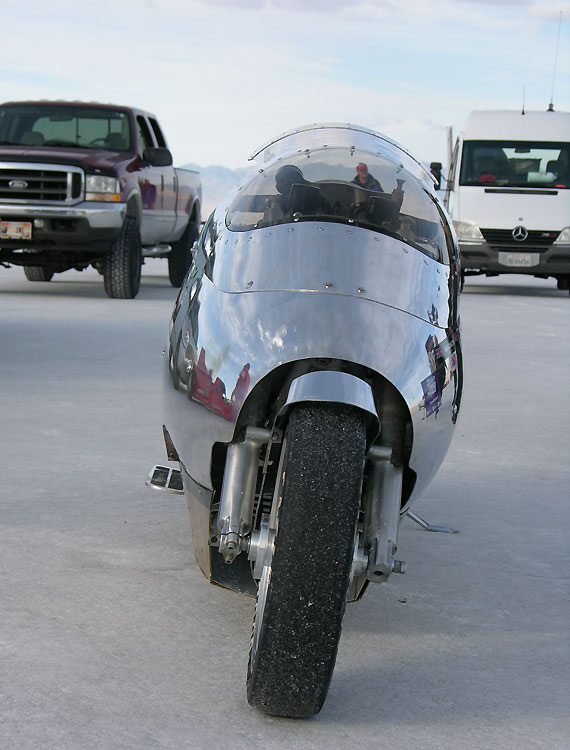
Make no mistake about it, when you deal with the big twins you are dealing as much with art as with science. Everything is hanging out in the open for everyone to look at and it is extremely difficult to blend function with aesthetics, especially in this era when every other bike is a "show bike" with every piece of billet trickery and chromed what nots glued or bolted to every exterior surface. We think our new turbos will meet the most demanding needs of any big twin whether it is trailer bound for the next show or caked in wet salt on its final record pass at Bonneville.
We will not compromise functionality however...so don't ask.